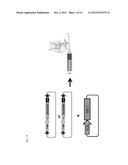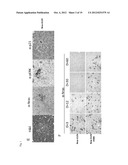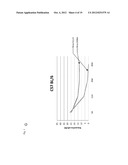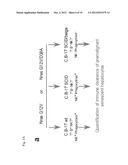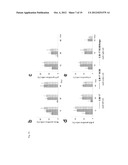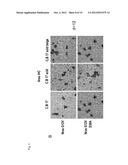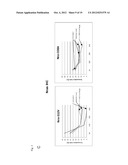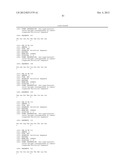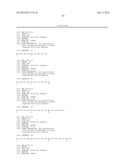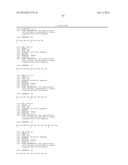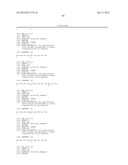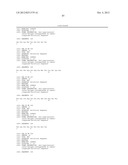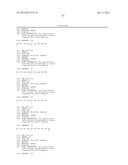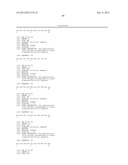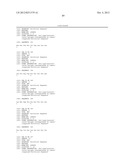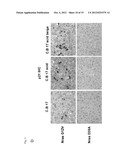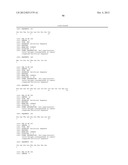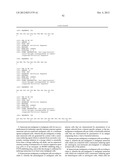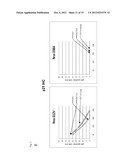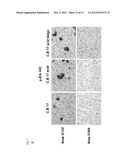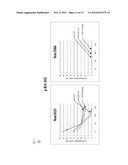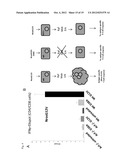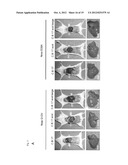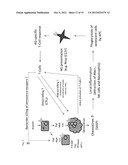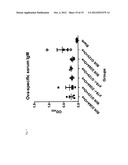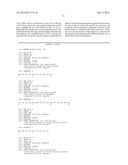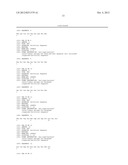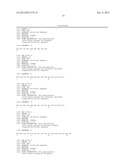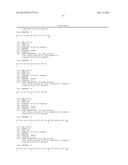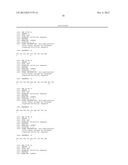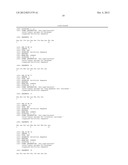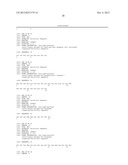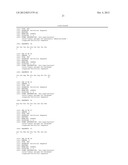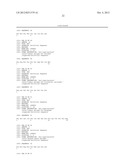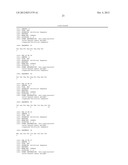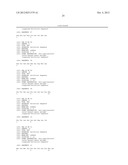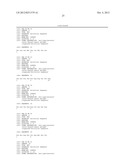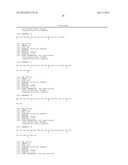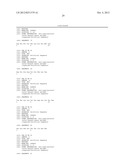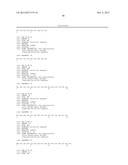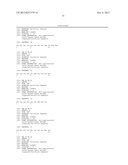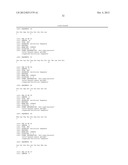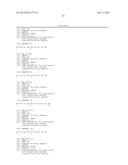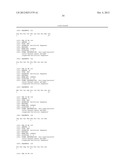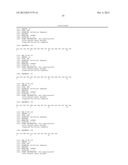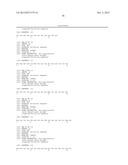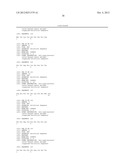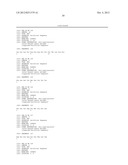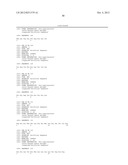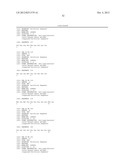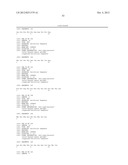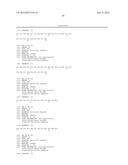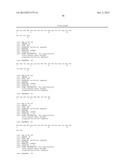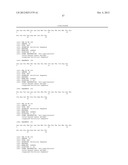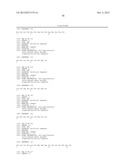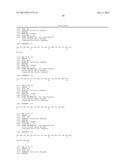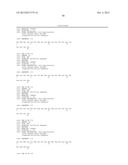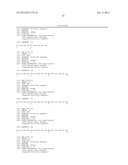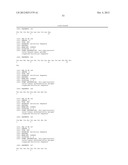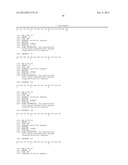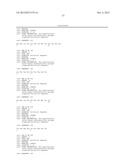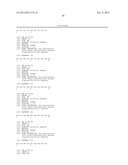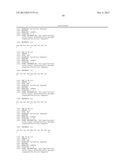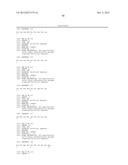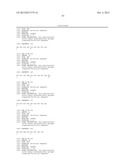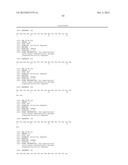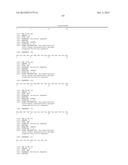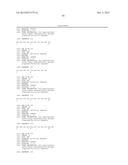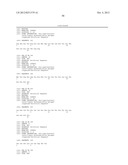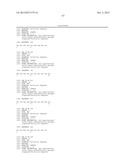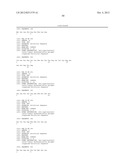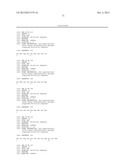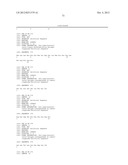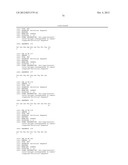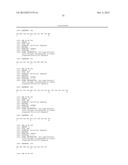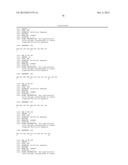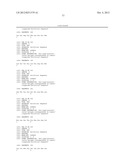Patent application title: COMPOSITIONS FOR GENERATING AN ANTIGEN SPECIFIC IMMUNE RESPONSE
Inventors:
Lars Zender (Hannover, DE)
Assignees:
HELMHOLTZ-ZENTRUM FUER INFEKTIONSFORSCHUNG GMBH
IPC8 Class: AA61K3512FI
USPC Class:
4242771
Class name: Drug, bio-affecting and body treating compositions antigen, epitope, or other immunospecific immunoeffector (e.g., immunospecific vaccine, immunospecific stimulator of cell-mediated immunity, immunospecific tolerogen, immunospecific immunosuppressor, etc.) cancer cell or component thereof
Publication date: 2012-10-04
Patent application number: 20120251579
Abstract:
The present invention provides for the purposeful utilisation of the
induction of senescence in eukaryotic cells for induction of an antigen
specific immune response. Such cells can be normal cells, pre-malignant
and malignant cells as well as virally or bacterially infected cells, for
the generation of an immune response, preferably a cellular or humoral
immune response comprising T-cells and/or B-cells, whose immune response
is directed specifically against antigens from those cells in which
senescence was induced and then comprises an immune response against the
senescent cells itself as well as to the non-senescent counterparts
harbouring the same antigens.Claims:
1. Senescent pre-malignant or malignant cells for use as a medicament for
inducing a specific immune response against senescent and non-senescent
malignant cells in a treatment against malignant cells, wherein the
pre-malignant or malignant senescent cells are generated by contact with
a senescence inducing agent which is selected from cytostatic compounds,
ionising radiation in a dosage which is essentially lower than a dosage
inducing cell death, and an expression cassette causing overexpression of
a tumour suppressor gene (e.g. p53) or of an oncogene, an MDM2 inhibiting
drug, a PTEN inhibiting drug, and in that the dosage is sufficient for
inducing senescence in at least some malignant cells.
2. Senescent pre-malignant or malignant cells according to claim 1, wherein the premalignant or malignant cells are tumour cells that are characterized by presentation of an antigen selected from a tumour-specific antigen, or the pre-malignant or malignant cells are virally or bacterially infected cells that are characterized by presentation of an antigen originating from a viral or bacterial infection.
3. Senescent pre-malignant or malignant cells according to claim 1, wherein the pre-malignant or malignant senescent cells which are contacted with a senescence inducing agent are autologous non-senescent pre-malignant or malignant isolated cells of the patient.
4. Senescent pre-malignant or malignant cells according to claim 1, wherein the pre-malignant or malignant senescent cells which are contacted with a senescence inducing agent are heterologous cells or autologous cells, which cells are genetically manipulated to contain a DNA construct expressing the antigen that is specific for the pre-malignant or malignant cell.
5. Senescent pre-malignant or malignant cells according to claim 1, wherein the specific immune response comprises T-cells directed against the malignant cells and/or B-cells producing antibody directed against the malignant cells.
6. Senescent pre-malignant or malignant cells according to claim 1, wherein a compound activating immune cells is present in combination with the senescence inducing agent or in combination with the senescent pre-malignant or malignant cells.
7. Senescent pre-malignant or malignant cells according to claim 1, wherein the senescent homologous malignant cell is formulated as a pharmaceutically acceptable formulation for implantation into the patient.
8. Immune cells for use as a medicament in a treatment against senescent and nonsenescent malignant cells, characterized in that the immune cells are primed for specificity against the pre-malignant and malignant cells by contact with senescent pre-malignant or malignant cells according to claim 1.
9. Immune cells according to claim 8, wherein the immune cells and the non-senescent malignant cells are autologous cells of one patient or heterologous cells from a different patient.
10. Immune cells according to claim 8, characterized in that the immune cells have acquired specificity for the malignant cell by contact of the immune cells with senescent malignant cells, and by integrating the immune cells into a pharmaceutically acceptable formulation for implantation into the patient.
11. Immune cells according to claim 8, characterized that the malignant cell is a tumour cell or a cell infected by a virus or a cell infected by a bacterium or a cell genetically manipulated to express a homologous or a heterologous antigen.
12. Process for producing senescent pre-malignant or malignant cells for use as a medicament in the treatment of malignant cells, the process comprising the steps of generating senescent malignant cells according to claim 1 by in vitro inducing senescence in autologous malignant cells, and formulating the senescent autologous malignant cells in a pharmaceutically acceptable formulation.
13. Process for producing antigen-specific immune cells for use as a medicament in the treatment of malignant cells, the process comprising the steps of generating senescent malignant cells according to claim 12 by in vitro inducing senescence in autologous malignant cells, in vitro contacting the senescent autologous malignant cells with autologous immune cells, and formulating the in a pharmaceutically acceptable formulation
14. Process according to claim 13, wherein following the step of in vitro contacting the senescent autologous or heterologous malignant cells with autologous immune cells, the autologous immune cells are separated from the senescent autologous malignant cells.
15. Process for producing antigen-specific immune cells, the process comprising the steps of generating senescent malignant cells according to claim 1 by transforming cells in an experimental animal with a nucleic acid construct encoding the antigen, inducing senescence in at least a fraction of the transformed cells within the experimental animal, followed by isolating spleen cells from the experimental animal, selecting immune cells having specificity for the antigen, and cultivating selected immune cells.
16. Process according to claim 15, characterized that the immune cells are B-cells, and a selected B-cell is fused with a tumour cell to generate a hybridoma, and cultivating the hybridoma for the production of antibody.
17. Pharmaceutical composition for use as a medicament in the treatment of malignant cells in a patient, the composition comprising in a pharmaceutically acceptable formulation a senescence inducing agent that is selected from cytostatic compounds and ionising radiation in a dosage which is essentially lower than a dosage inducing cell death, overexpression of a tumour suppressor gene or an oncogene and in that the dosage is sufficient for inducing senescence in at least some malignant cells.
18. Pharmaceutical composition according to claim 17, characterized that the pharmaceutical composition in combination with the senescence inducing agent comprises a compound activating immune cells.
19. Pharmaceutical composition for use in the medical treatment of malignant cells in a patient, the composition comprising in a pharmaceutically acceptable formulation for introduction into a patient an autologous immune cell of the patient, which immune cell is specific for the malignant cell by being contacted in vitro with a senescent malignant cell that is autologous to the patient.
20. Senescence inducing agent for use as a medicament in the generation of senescent premalignant or malignant cells according to claim 1, which is selected from cytostatic compounds, ionising radiation in a dosage which is essentially lower than a dosage inducing cell death, and an expression cassette causing overexpression of a tumour suppressor gene (e.g. p53) or of an oncogene, treatment with an MDM2 inhibitor, a PTEN inhibitor and in that the dosage is sufficient for inducing senescence in at least some malignant cells.
Description:
[0001] The present invention relates to the purposeful utilisation of the
induction of senescence in eukaryotic cells for induction of an immune
response. Such cells can be normal cells, pre-malignant and malignant
cells as well as virally or bacterially infected cells, for the
generation of an immune response, preferably a cellular or humoral immune
response comprising T-cells and/or B-cells, whose immune response is
directed specifically against antigens from those cells in which
senescence was induced and then comprises an immune response against the
senescent cells itself as well as to the non-senescent counterparts
harbouring the same antigens. The immune response induced by presence of
senescent malignant cells is directed against malignant cells, both in
their senescent state and in their non-senescent state, e.g. in a normal
cell cycle phase, including a phase of proliferation of malignant cells,
and including pre-malignant cells, e.g. chronically virally or
bacterially infected cells, e.g. chronically infected liver cells. For
utilisation of the senescence induced antigen specific immune response,
specifically directed against malignant cells, the invention provides
pharmaceutical compositions, e.g. for use as a medicament, especially for
use in the treatment of malignant cells, and the use of compounds for the
production of pharmaceutical compositions, which compounds generate
senescent premalignant or malignant cells, which are the causative agent
of the generation of the malignant cell--specific immune response, and
further provides pharmaceutical compositions comprising the senescent
malignant cells as the causative agent for generating the immune response
directed against the malignant cells, as well as pharmaceutical
compositions comprising the immune cells, especially T-cells and B-cells,
which are specific for the malignant cells, which immune cells are
generated by contacting non-primed immune cells with senescent malignant
cells in the presence and/or in the absence of antigen presenting cells
(APCs). Further, the invention relates to the utilisation of the
induction of a specific (antigen specific) immune response effected by
the presence of senescent cells for the production of antigen--specific
immune cells in an experimental animal, i.e. in a non-human mammal, e.g.
in a mouse. For the purposes of the invention, the term "medicament" is
used interchangeably with the term "pharmaceutical composition" or
"pharmaceutical agent".
[0002] In contrast to the state of art which shows that the artificial induction of senescence raises an immune response by the innate immune system, i.e. a non-adaptive immune response, the present invention is based on the finding that the cellular senescence program is a very efficient inducer of an adaptive immune response, e.g. T-cells and B-cells are induced. Due to their naturally occurring secretory phenotype and an increased expression of cellular adhesion molecules, senescent cells are an ideal target for phagocytosis by APC, which then cross-present antigens from the senescent cells (in the case of the experimental data presented here antigens are peptides from the Kras oncogene) to effectively activate B- or T-Cells. Some cell types (e.g. liver cells), upon senescence induction, will also be able to directly present antigens to adaptive immune cells. The specificity of the cells and of antibody secreted by respective specific B-cells is directed against antigen contained in the senescent malignant cell, e.g. presented to the immune system by MHC I and/or MHC II of the senescent malignant cell, so that the specificity of the immune response is e.g. specific for the intracellular antigen e.g. in a malignant or in a virally infected cell.
[0003] Accordingly, in certain embodiments of the invention, the generation of specific T-cells and/or B-cells by contacting immune cells with senescent malignant cells or non malignant senescent cells overexpressing a certain antigen, e.g. a tumour antigen, is described, which can be used for the production of antibodies, the antibody having specificity for an antigen that is expressed by the malignant cell, e.g. after transformation of the malignant cell due to transfection or transformation with an antigen encoding nucleic acid sequence. In this embodiment, the cell expressing the antigen is considered a malignant cell for the purposes of this invention, and the cell can be selected essentially from any type of cell. The advantage of using the stimulation of immune cells with senescent malignant cells or non malignant senescent cells overexpressing a certain tumour antigen, which are cells expressing an antigen, for generating a T-cell and/or a B-cell secreting an antibody specific for the antigen is the high specificity and high effectiveness of the generation of a specific immune response by contacting immune cells, preferably non-primed immune cells, with senescent malignant cells. Preferably, the malignant cell in the embodiments of the invention is a cell, present in vitro or in vivo in a human patient or in an experimental animal, is expressing the antigen against which an immune response is desired, which malignant cell is present in its state of senescence and in contact with the immune cells, either in vitro or in vivo, e.g. in a human patient or in an experimental animal, i.e. in a non-human mammal. Preferably, the induction of an antigen-specific immune response is monitored, e.g. by using an ELISPOT assay to detect antigen-specific T-Lymphocytes or by using a B-cell antibody ELISA.
State of the art
[0004] WO 2009/042798 describes a treatment of fibrosis of the liver by administration of an agent promoting the senescence of myofibroblasts in fibrotic tissue, optionally in combination with the administration of an immuno stimulant for activating or recruiting the innate immune system in fibrotic tissue. For inducing the senescence of myofibroblasts, and a viral expression vector encoding p53, p21/Cip1/Waf1 cyclin dependent kinase inhibitor or a miR-34 class of microRNA, or encoding a short-hairpin RNA molecule for causing post-transcriptional silencing of cycline-dependant kinases 2 or 4 is used.
[0005] Xue et al in Nature, 656-660 (2007) describe that innate immune cells were activated in athymic nude mice against intraspleenically injected purified embryonic liver progenitor cells, that were transduced with retroviruses expressing oncogenic ras (HrasV12) upon expression of p53. p53 was produced intracellularly by suppressing the transcription of a short-hairpin RNA directed against the natural p53 transcript by the administration of the antibiotic doxycycline. It was shown that expression of p53 resulted in the activation of senescence in tumour cells, and in the involution of the tumour by the innate immune system. Novellino et al, Cancer Immunol. Immunother. (2005) 54: 187-207, list tumour specific antigens.
Objects of the invention
[0006] It is an object of the present invention to provide for pharmaceutical compositions suitable for use against malignant cells.
General Description of the Invention
[0007] The invention achieves the above-mentioned objects by the subject-matter defined in the claims, and especially by providing the compounds for use as a medicament for use in the treatment of pre-malignant and/or of malignant cells, especially for inducing an immune response specifically directed against the malignant cells, the use of compounds for the production of pharmaceutical compositions suitable for use against cells expressing certain antigens, which for the present invention provide malignant cells, e.g. tumour cells and pre-malignant cells, as well as infected cells, e.g. cells containing an infecting virus or bacterium, especially chronically infected cells.
[0008] Generally, the present invention provides the use of compositions and pharmaceutical compositions for use as a medicament in the treatment of malignant cells by providing or inducing an adapted immune response, preferably including both cytotoxic T-cells and antibody producing cells, e.g. B-cells, which are specifically directed against malignant cells and premalignant cells. The compositions of the invention achieve the generation of a cellular and/or antibody-based immune response which is specifically directed against malignant cells by inducing immune cells, including professional antigen presenting cells for specificity against malignant cells by contacting immune cells with senescent premalignant or malignant cells.
[0009] Senescence of cells can generally be described by the following features of cells: A flattened morphology, optionally showing two or more nuclei, staining for SA-β-Gal (senescence associated β-galactosidase) positive, at least one immunohistochemical marker positive from the group of p19, p21, p53, p16, DCR2, DEK1, a reduced metabolic activity, and further optionally their resistance against the induction of apoptosis. According to the invention, compositions inducing the senescence of malignant cells can be provided to generate senescent malignant and premalignant cells in contact with the immune system, as it has been shown by the present inventors that senescent cells efficiently induce the generation of a specific immune response, including T-cells and antibody producing cells, e.g. B-cells, i.e. a cellular and humoral immune response, which is specifically directed against the senescent cell, e.g. against the antigen characterizing the malignant cell. Currently, it is assumed that by a bystander effect, the specific immune response raised is also directed against non-senescent cells expressing the same antigen, which would normally not be sufficient to induce an immune response without the interconnection of induction of an antigen specific immune response via senescent cells. In detail, the immune specificity of T-cells and B-cells which is elicited by contacting immune cells, preferably including professional antigen presenting cells (APC) with senescent malignant or premalignant cell, which is e.g. a virally or bacterially infected cell, is directed against antigen presented by MHC I and/or MHC II of the cell, e.g of the senescent cell. Preferably, pre-malignant cells are chronically infected cells, e.g. cells having a chronic viral or bacterial infection, e.g. by a hepatitis virus.
[0010] Accordingly in another embodiment, the compounds of the invention comprise senescent malignant cells for use in the production of a pharmaceutical composition for the medical use of generation of a specific immune response, which immune response is directed against an antigen of the malignant cell. Accordingly, the premalignant or malignant homologous senescent cell, e.g. prepared from a homologous or autologous premalignant or malignant cell obtained from the patient or animal by contacting the cell with a senescence inducing agent, can be used as a medicament, e.g. in tumour therapy, especially for inducing a specific immune response against the premalignant or malignant cell. The specific immune response induced by administration of autologous or homologous senescent premalignant or malignant cells comprises the cellular immune response, e.g. T-cells, and antibody production, e.g. antigen-specific B-cells. The antigen characterizing the malignant or pre-malignant cell can be a tumor-specific antigen, or a viral antigen or a bacterial antigen contained in the malignant or pre-malignant cell. In case that a pathogen (e.g. virus or bacterium) has been phagocytosed by an innate immune cell, this cell is referred to as a malignant cell, too, and will be a malignant cell in the terms of the invention that is subjected to senescence induction. For the purposes of the invention, the terms malignant and pre-malignant can be used interchangeably.
[0011] As the immune response, which is specifically raised and directed against malignant cells, comprises antigen-specific T-cells and/or B-cells producing antigen-specific antibody, the compounds of the invention can be used to generate an adapted, i.e. specific immune response comprising both cellular and humoral immune responses directed against cells which via MHC present the specific antigen, including cells in their active cell cycle, e.g. non-senescent cells, like actively proliferating tumour cells and infected cells.
[0012] In a first embodiment, the invention provides the use of an agent suitable for inducing senescence in non-senescent malignant cells for the production of a pharmaceutical composition for medical use against malignant cells, which are e.g. tumour cells or infected cells. The senescence inducing agent, e.g. a cytostatic agent or a chemotherapeutical agent or irradiation, especially radioactive irradiation, overexpression of p53 or p14Arf, or Nutlin, especially the MDM2-inhibitor Nutlin-3 ((+/-)-4-[4,5-Bis(4-chlorophenyl)-2-(2-isopropoxy-4-methoxyphenyl)-4,5-di- hydroimidazol-1-carbonyl]-piperazin-2-on), and/or a PTEN-inhibitor, e.g. VO-OHpic is used to contact non-senescent malignant and/or premalignant cells in vivo or in vitro for the generation of senescent malignant cells, which are contacted with immune cells in vitro or in vivo, i.e. in the body of the patient. By the contact with the senescent malignant cells, the immune cells, preferably including APC, are induced to produce a specific immune response directed against the malignant cells. In an in vivo application, the pharmaceutical composition has a dosage effective to induce senescence in at least a fraction of malignant or premalignant cells within a patient, preferably at a non-cytotoxic dosage, e.g. by administration of a the senescence-inducing agent at an effective dosage less than the dosage required for inducing apoptosis, e.g. less than the dosage required for IC 50.
[0013] Accordingly, the invention in this embodiment provides senescence inducing compounds for use as a medicament for the treatment of malignant cells by induction of a cellular and humoral immune response that is specific for the malignant cells, e.g. specifically directed against an antigen characterizing the malignant cells. Accordingly, the senescence inducing compounds in this embodiment are adapted or prepared for inducing the senescence of malignant cells, which in turn induces a specific immune response against the malignant cells. Generally, such compounds include cytostatic compounds at a dosage sufficient to induce senescence of malignant cells in vivo, which dosage is sufficiently low to essentially not impair the immune system. Such a dosage could be in a range of 10 to 50%, preferably at 15 to 30% of the dosage of chemotherapy and could e.g. be used for the treatment of patients having a general health status that would sustain full chemotherapy.
[0014] Preferably, the provision of senescent malignant cells within a patient generated from non-senescent malignant cells by administration of a pharmaceutical composition containing a senescence-inducing agent, is in combination with the administration of an immuno-stimulant in order to enhance the activity of the immune system, preferably enhancing the activity of APC and T-cells. Accordingly, the invention also provides for the use of an immuno-stimulating agent for use as a medicament and/or for the production of a pharmaceutical composition for use against malignant cells, especially in combination with the use of a senescence-inducing compound as a medicament and/or for the production of a pharmaceutical composition, as well as providing for a pharmaceutical composition comprising a senescence-inducing compound in combination with an immuno-stimulating agent or compound for use as a medicament for use in the treatment of malignant cells. In the first embodiment, the pharmaceutical composition is used as a medicament, e.g. for use in the treatment of malignant cells, to generate senescent malignant cells within a patient in order to induce the generation of a specific immune response, preferably comprising both specific T-cells and B-cells generating specific antibody, which is directed against at least one antigen of the malignant cell. For enhancing the generation of the specific cellular and/or specific humoral immune response directed against the antigen of the malignant cell, an immuno-stimulating agent can be administered, preferably in combination with the pharmaceutical composition containing the senescence-inducing compound. Accordingly, the use of a senescence-inducing compound for the production of a pharmaceutical composition for use against malignant cells is also provided in combination with the use of a immuno-stimulating agent for the production of the pharmaceutical composition for use against malignant cells.
[0015] In a second embodiment, the specific immune response, especially T-cells which are specifically directed against the malignant cells (or antibodies produced by B-cells), is generated from autologous immune cells of the patient in vitro by contacting autologous immune cells of the patient with senescent malignant cells, especially homologous or autologous malignant cells of the patient or senescent non-malignant cells overexpressing an antigen. In this embodiment, the invention provides for the use of homologous, preferably autologous malignant or non-malignant cells of a patient as a medicament and/or for the production of a pharmaceutical composition for use in the medical treatment against malignant cells, especially against tumour cells and/or infected cells, the pharmaceutical composition comprising senescent homologous malignant cells, preferably senescent autologous malignant or premalignant cells of the patient in a formulation for implantation into the patient, e.g. by formulating the senescent autologous malignant cells for injection into the patient. In this embodiment, senescent malignant cells for use as a medicament for use in the treatment of malignant cells, which are e.g. tumour cells and/or chronically infected cells, and/or in the production of the pharmaceutical composition can be generated from isolated autologous malignant cells or non-malignant cells by contacting with a senescence-inducing agent, e.g. by contacting autologous malignant cells with a cytostatic agent or radioactive irradiation at a dosage below the dosage required for inducing apoptosis, e.g. below the dosage corresponding to the IC50 or by using other senescence inducing compounds as described below. Malignant cells can be obtained from the patient's tumour (to be then subjected to a senescence inducing agent) or generated by in vitro genetic manipulation, e.g. by transient or permanent transformation, of homologous cells, preferably autologous cells of the patient with a nucleic acid construct encoding an antigen against which an immune response is desired, expressing the antigen in the genetically manipulated cells, and inducing senescence. The genetic manipulation of cells of the patient is preferred for a heterologous antigen, e.g. for use in the treatment of chronic infections (e.g. the heterologous antigen selected from viral or bacterial protein) or for homologous antigen characteristic of a disease like a tumour antigen (e.g. MUC1), to produce senescent malignant cells characterized by the antigen, as these cells will induce an effective immune response after re-introduction into the patient. Alternative methods for senescence induction are, as described, overexpression of certain oncogenes (e.g. oncogenic Ras) or overexpression of tumour suppressor genes, e.g. p14Arf or p53, or contacting with MDM2-inhibitor, e.g. Nutlin, or contacting with a PTEN-inhibitor, e.g. VO-OHpic.
[0016] In this embodiment, the pharmaceutical composition of the invention comprises senescent autologous malignant cells for use in the medical treatment of malignant cells, e.g. senescent tumour cells or infected cells, especially for use as a medicament, in a formulation for injecting the senescent malignant cells into the patient. This embodiment makes use of the observation that senescent malignant or premalignant cells potently induce a specific cellular and/or humoral immune response, specifically directed against the antigen presented by the senescent malignant cell. Accordingly, in this and other embodiments it is preferred that the pharmaceutical composition comprises an immuno-stimulating agent, e.g. an interferon and/or cytokine for general activation of the immune system. Optionally, senescent pre-malignant or malignant cells containing the antigen against which the induction of a specific immune response is desired can be generated by genetic manipulation of autologous/homologous or also heterologous cells (i.e. from other individuals), e.g. in vitro using cells obtained from a patient, for introduction of an expression cassette encoding an antigen against which a specific immune response is desired, followed by inducing senescence of the cells. As an example, autologous cells can be nucleated cells, e.g. fibroblasts, which after genetic manipulation in vitro for expression of the antigen and after induction of senescence are used as a medicament for use in the treatment against cells within the patient for treatment against malignant cells expressing the same antigen. In a further embodiment, the senescent malignant cells obtained by in vitro manipulation for expression of the antigen (e.g. by introduction of an expression cassette encoding the antigen into the autologous cells in vitro) are contacted in vitro with un-primed immune cells obtained from the patient for priming the immune cells for specificity against the antigen. Priming of the immune cells against the antigen can either occur in vivo in the patient (after administration of the cells into the patient, or, alternatively, the immune cells can be primed by in vitro contacting with senescent cells expressing the antigen, e.g. malignant cells, and are then used as a medicament, especially for use in the treatment of cells expressing the antigen, e.g. in the treatment of malignant cells which are characterized by expressing the antigen. Alternatively, a patient's tumour cells expressing a certain tumour antigen can be isolated, subjected to senescence induction outside the patient and then be re-transplanted into the patient to induce an antigen specific immune response against the residual tumour cells.
[0017] In a third embodiment, the invention provides for the use of homologous, especially of autologous immune cells for the production of a pharmaceutical composition for the medical treatment of malignant cells, especially tumour cells and infected cells in a patient, wherein the immune cells are specific for the malignant cell. For generating immune cells having specificity for malignant cells, homologous and preferably autologous immune cells of a patient are in vitro contacted with malignant cells of the patient in which malignant cells ex vivo, e.g. in vitro, senescence has been induced. Generally, the immune cells are preferably homologous or autologous to the patient. Alternatively, normal cells from a patient (e.g. skin fibroblasts) can be taken in culture, an antigen of choice (e.g. a viral antigen, a bacterial antigen or a tumour antigen) will be delivered into these cells and subsequently senescence will be induced in these cells to generate senescent malignant cells. Antigen presenting cells and adaptive immune cells can then be contacted with these cells to induce antigen specific immune cells. In this embodiment, a pharmaceutical composition for the treatment of malignant cells in a patient can be generated by contacting autologous immune cells, which are e.g. isolated from the patient, with senescent malignant cells, as it has been found that the presence of senescent malignant cells in contact with immune cells leads to the generation of a specific immune response of the immune cells directed against the senescent malignant cells. As described in the other embodiments of the invention, senescent malignant cells can be generated by inducing senescence in malignant cells, e.g. in homologous or autologous immune cells derived from the patient by contacting with a senescence--inducing agent, e.g. a cytostatic agent or irradiation at a dosage below the dosage inducing apoptosis or by gene transfer or by other senescence inducing compounds as described below. Preferably, in this embodiment the pharmaceutical composition comprising cells specifically directed against malignant cells by contacting the immune cells with senescent malignant cells is a formulation suitable for implantation of the immune cells into the patient.
[0018] As described in relation to the second embodiment, a senescent malignant cell can be generated from an autologous cell of the patient by direct in vitro contacting with a senescence inducing agent or by genetic manipulation with a nucleic acid sequence encoding an antigen, e.g. a homologous or a heterologous antigen specific for a tumour, a virus or bacterium, and subsequent senescence induction. The in vitro generation of immune cells specifically directed against senescent and non-senescent cells having the antigen is by contacting immune cells with the genetically manipulated senescent cells expressing the antigen, preferably followed by isolating antigen-specific primed immune cells, most preferably followed by isolating antigen-specific primed immune cells and expanding these, optionally with subsequent integration of these cells into a formulation suitable for introduction into the patient.
[0019] In a fourth embodiment, the invention relates to a process for producing immune cells specific for an antigen contained in a malignant cell, e.g. for producing B-cells and/or T-cells specifically directed against a malignant cell. In this embodiment, the invention also relates to a process for producing antibody by cultivating B-cells which have been generated to produce antibody specifically directed against an antigen presented by the malignant cell. The process comprises the step of introducing an antigen, against which immune specificity is to be generated in a cell, e.g. by transforming a cell with a nucleic acid construct comprising a sequence encoding the antigen, preferably in an expression cassette. The cells containing the antigen, which are for the purposes of this invention also related to as malignant cells, are subject to a treatment to induce their senescent state, i.e. by contacting with a senescence inducing agent to generate senescent malignant cells, which contain, and preferably express the antigen. In this embodiment, the malignant cells are cells that are genetically manipulated to express the antigen against which an immune response is desired, including one or both of cellular immune response and antibody production. These senescent, antigen-containing cells are then contacted with immune cells, preferably B-cells and/or T-cells, most preferably in the presence of APC. Using isolation of cells and identification of cells having the specificity against the antigen, especially B-cells producing an antibody specific for the antigen by standard immuno assays. For antigen-specific T-cells, it is preferred to use an Elispot assay for identification, for antibody producing B-cells, an ELISA can be used. Preferably, the cells subjected to the introduction of an expression cassette encoding the antigen are autologous cells of the experimental animal, and more preferably, these genetically manipulated cells are subjected to induction of senescence in vitro and then transferred back into the animal.
[0020] For the production of antibody, especially for the production of monoclonal antibody, it is preferred to fuse the B-cell producing the antibody against the antigen using hybridoma technique, and cultivating the resultant antibody producing hybridoma.
[0021] In the fourth embodiment, the process for producing antigen-specific immune cells, especially for producing antibody, can be using an experimental animal, e.g. a mouse, rats, goat, sheep, by transforming cells, especially spleen cells with a nucleic acid construct expressing the antigen, e.g. using a viral vector containing an expression cassette encoding the antigen, and inducing senescence in at least a fraction of the transformed cells, e.g. by application of a senescence-inducing agent, followed by isolation of spleen cells. From the isolated spleen cells, an immune cell can be isolated having the specificity against the antigen used, especially selecting a B-cell producing an antibody specific for the antigen as described above, preferably followed by generating a hybridoma using fusion with a tumour cell, followed by cultivation of the hybridoma for producing the antibody.
[0022] In greater detail, the invention provides evidence that induction of a specific immune response is caused by contacting of the immune cells with malignant cells, e.g. tumour cells, virally or bacterially infected cells or cells expressing an antigen. The strong immune response induced by presence of the senescent cells presenting antigen was shown on the example of normal epithelial cells, represented by liver cells, which express oncogenic ras, in the state of senescence. For the purposes of this invention, the term "malignant cell" relates to an animal or human cell, in case of pharmaceutical compositions of the invention preferably to homologous/autologous cells of the patient or heterologous cells, which express an antigen, either due to malignancy of the cell, as in the case of tumour cells, and in the case of purposes of antibody production, the term "malignant cell" also relates to cells which are transformed with a coding sequence encoding an antigen for expressing the antigen, preferably an antigen heterologous to the cell.
[0023] In the following detailed section, experimental proof is provided for the observation that innate immune cells as well as adapted immune cells are infiltrating in the tissue upon induction of senescence in malignant cells, e.g. infiltrate the liver upon induction of senescence in malignant cells. Various control experiments demonstrate that an antigen specific immune response, the antigen characterising the malignancy of the malignant cells, is raised by presence of senescent malignant cells, including senescent pre-malignant cells. The antigen-specific immune response directed against the senescent malignant and pre-malignant cells is sufficient for clearance of malignant and pre-malignant cells, both in their senescent and in their non-senescent state. A defect in the adaptive immunity pathway, e.g. the genetic SCID defect (defects in function of T-lymphocytes, B-lymphocytes, and of NKT-cells), completely abrogates the generation of antigen-specific immune cells, whereas IFN-gamma-Elispot analysis demonstrates presence of antigen-specific T-cells which are directed against the factor which determines malignancy of the malignant senescent cells, which is in the present case represented by the exemplary oncogenic Nras, e.g. in a non-defective immune system. The finding that an Arf -/- the genotype, which bypasses the induction of senescence in malignant cells, prevents the induction of a specific T-cell response demonstrates that it is the presence of senescent malignant cells which induces the antigen-specific immune response.
[0024] Preferably, the malignant cell is characterized by presenting a tumor-specific antigen, which accordingly is not expressed by non-malignant and not by non-premalignant cells. Tumor-specific antigen include those which are e.g. mentioned in Novellino et al, Cancer Immunol. Immunother. (2005) 54: 187-207, which is included herein by reference in respect of tumour specific antigens. Preferably, a tumour specific antigen is one of the group comprising or consisting of tumour antigens resulting from mutations, shared tumour antigens, differentiation antigens, antigens overexpressed in tumours, especially Nras, Hras, Kras which are indicative of a neoplastic state, tumour-specific antigens of the MAGE (including MAGE-B5, MAGE-B6, MAGE, MAGE-C2, MAGE-C3, MAGE-D), HAGE, SAGE, SSX-2, BAGE, TRAG-3, and GAGE families, including NY-ESO-1, LAGE, CAMEL, as well as MUC1, most preferably tumour-specific mutant Ras, e.g. Nras, Nras G12V, or Kras, KrasG12D and other common mutations.
[0025] Exemplary tumour antigens resulting from mutations are for lung carcinoma FIASNGVKLV, for melanoma YSVYFNLPADTIYTN, for chronic myeloid leukemia SSKALQRPV or GFKQSSKAL or ATGFKQSSKALQRPVAS or ATGFKQSSKALQRPVAS, for melanoma EDLTVKIGDFGLATEKSRWSGSHQFEQLS, for colorectal, gastric, and endometrial carcinoma FLIIWQNTM, for head and neck squamous cell carcinoma FPSDSWCYF, for melanoma SYLDSGIHF, for melanoma FSWAMDLDPKGA, for melanoma ACDPHSGHFV, for melanoma AVCPWTWLR, for colorectal carcinoma TLYQDDTLTLQAAG or TLYQDDTLTLQAAG, for myeloid leukemia TMKQICKKEIRRLHQY, for melanoma KILDAVVAQK, for lung squamous CC especially ETVSEQSNV, for acute lymphoblastic leukemia RIAECILGM or IGRIAECILGMNPSR or IGRIAECILGMNPSR, for acute myelogenous leukemia YVDFREYEYY, for melanoma MIFEKHGFRRTTPP, for melanoma TLDWLLQTPK, for melanoma WRRAPAPGA or PVTWRRAPA, for renal cell carcinoma, for melanoma and renal cell carcinoma SLFEGIDIYT, for bladder tumour AEPINIQTW, for melanoma FLEGNEVGKTY, for non-small cell lung carcinoma FLDEFMEGV, for melanoma EEKLIVVLF, for melanoma SELFRSGLDSY or FRSGLDSYV, for melanoma EAFIQPITR, for melanoma RVIKNSIRLTL, for melanoma KINKNPKYK, lung squamous cell carcinoma QQITKTEV, colorectal carcinoma SLYKFSPFPL, for melanoma KELEGILLL, for head and neck squamous cell carcinoma VVPCEPPEV, for promyelocytic leukemia NSNHVASGAGEAAIETQSSSSEEIV, for melanoma LLLDDLLVSI, for melanoma PYYFAAELPPRNLPEP, for pancreatic adenocarcinoma VVVGAVGVG, for melanoma ILDTAGREEY, for melanoma RPHVPESAF, for melanoma KIFSEVTLK, for melanoma SHETVIIEL, for sarcoma QRPYGYDQIM, for colorectal carcinoma RLSSCVPVA, for melanoma GELIGILNAAKVPAD.
[0026] Exemplary shared tumour antigens are:
[0027] AARAVFLAL, YRPRPRRY, YYWPRPRRY, VLPDVFIRC(V), MLAVISCAV, RQKRILVNL, NYNNFYRFL, EYSKECLKEF, EYLSLSDKI, MLMAQEALAFL, SLLMWITQC, LAAQERRVPR, ELVRRILSR, APRGVRMAV, SLLMWITQCFLPVF, QGAMLAAQERRVPRAAEVPR, AADHRQLQLSISSCLQQL, CLSRRPWKRSWSAGSCPGMPHL, CLSRRPWKRSWSAGSCPGMPHL, ILSRDAAPLPRPG, AGATGGRGPRGAGA, EADPTGHSY, KVLEYVIKV, SLFRAVITK, EVYDGREHSA, RVRFFFPSL, EADPTGHSY, REPVTKAEML, DPARYEFLW, ITKKVADLVGF, SAFPTTINF, SAYGEPRKL, SAYGEPRKL, TSCILESLFRAVITK, PRALAETSYVKVLEY, FLLLKYRAREPVTKAE, EYVIKVSARVRF, YLQLVFGIEV, EYLQLVFGI, REPVTKAEML, EGDCAPEEK, LLKYRAREPVTKAE, EVDPIGHLY, FLWGPRALV, KVAELVHFL, TFPDLESEF, VAELVHFLL, MEVDPIGHLY, EVDPIGHLY, REPVTKAEML, AELVHFLLL, MEVDPIGHLY, WQYFFPVIF, EGDCAPEEK, KKLLTQHFVQENYLEY, KKLLTQHFVQENYLEY, ACYEFLWGPRALVETS, VIFSKASSSLQL, VIFSKASSSLQL, GDNQIMPKAGLLIIV, TSYVKVLHHMVKISG, RKVAELVHFLLLKYRA, FLLLKYRAREPVTKAE, EVDPASNTY, GVYDGREHTV, NYKRCFPVI, SESLKMIF, MVKISGGPR, EVDPIGHVY, REPVTKAEML, EGDCAPEEK, ISGGPRISY, LLKYRAREPVTKAE, ALSVMGVYV, GLYDGMEHL, DPARYEFLW, FLWGPRALV, VRIGHLYIL, EGDCAPEEK, REPFTKAEMLGSVIR, AELVHFLLLKYRAR, LLFGLALIEV, ALKDVEERV, SESIKKKVL, PDTRPAPGSTAPPAHGVTSA, QGQHFLQKV, SLLMWITQC, MLMAQEALAFL, ASGPGGGAPR, LAAQERRVPR, TVSGNILTIR, APRGPHGGAASGL, MPFATPMEA, KEFTVSGNILTI, MPFATPMEA, LAMPFATPM, ARGPESRLL, SLLMWITQCFLPVF, LLEFYLAMPFATPMEAELARRSLAQ, LLEFYLAMPFATPMEAELARRSLAQ, EFYLAMPFATPM, RLLEFYLAMPFA, QGAMLAAQERRVPRAAEVPR, PGVLLKEFTVSGNILTIRLT, VLLKEFTVSG, AADHRQLQLSISSCLQQL, LLEFYLAMPFATPMEAELARRSLAQ, LKEFTVSGNILTIRL, PGVLLKEFTVSGNILTIRLTAADHR, LLEFYLAMPFATPMEAELARRSLAQ, AGATGGRGPRGAGA, LYATVIHDI, ILDSSEEDK, KASEKIFYV, EKIQKAFDDIAKYFSK, WEKMKASEKIFYVYMKRK, KIFYVYMKRKYEAMT, KIFYVYMKRKYEAM, INKTSGPKRGKHAWTHRLRE, YFSKKEWEKMKSSEKIVYVY, MKLNYEVMTKLGFKVTLPPF, KHAWTHRLRERKQLVVYEEI, LGFKVTLPPFMRSKRAADFH, KSSEKIVYVYMKLNYEVMTK, KHAWTHRLRERKQLVVYEEI, SLGWLFLLL, LSRLSNRLL, LSRLSNRLL, CEFHACWPAFTVLGE, CEFHACWPAFTVLGE, CEFHACWPAFTVLGE, EVISCKLIKR or CATWKVICKSCISQTPG.
[0028] Exemplary tumour differentiation antigens are:
[0029] YLSGANLNL, IMIGVLVGV, GVLVGVALI, HLFGYSWYK, QYSWFVNGTF, TYACFVSNL, AYVCGIQNSVSANRS, DTGFYTLHVIKSDLVNEEATGQFRV, YSWRINGIPQQHTQV, TYYRPGVNLSLSC, EIIYPNASLLIQN, YACFVSNLATGRNNS, LWWVNNQSLPVSP, LWWVNNQSLPVSP, LWWVNNQSLPVSP, EIIYPNASLLIQN, NSIVKSITVSASG, KTWGQYWQV, (A)MLGTHTMEV, ITDQVPFSV, YLEPGPVTA, LLDGTATLRL, VLYRYGSFSV, SLADTNSLAV, RLMKQDFSV, RLPRIFCSC, LIYRRRLMK, ALLAVGATK, IALNFPGSQK, ALNFPGSQK, ALNFPGSQK, VYFFLPDHL, RTKQLYPEW, HTMEVTVYHR, SSPGCQPPA, VPLDCVLYRY, LPHSSSHWL, SNDGPTLI, GRAMLGTHTMEVTVY, WNRQLYPEWTEAQRLD, TTEWVETTARELPIPEPE, TGRAMLGTHTMEVTVYH, GRAMLGTHTMEVTVY, SVSESDTIRSISIAS, LLANGRMPTVLQCVN, RMPTVLQCVNVSVVS, PLLENVISK, (E)AAGIGILTV, ILTVILGVL, EAAGIGILTV, AEEAAGIGIL(T), RNGYRALMDKS, EEAAGIGILTVI, AAGIGILTVILGVL, APPAYEKLpSAEQ, EEAAGIGILTVI, RNGYRALMDKSLHVGTQCALTRR, MPREDAHFIYGYPKKGHGHS, KNCEPVVPNAPPAYEKLSAE, SLSKILDTV, LYSACFWWL, FLTPKKLQCV, VISNDVCAQV, VLHWDPETV, MSLQRQFLR, ISPNSVFSQWRVVCDSLEDYD, SLPYWNFATG, SVYDFFVWL, TLDSQVMSL, LLGPGRPYR, LLGPGRPYR, ANDPIFVVL, QCTEVRADTRPWSGP, ALPYWNFATG, KCDICTDEY, SSDYVIPIGTY, MLLAVLYCL, CLLWSFQTSA, YMDGTMSQV, AFLPWHRLF, QCSGNFMGF, TPRLPSSADVEF, LPSSADVEF, LHHAFVDSIF, SEIWRDIDF, QNILLSNAPLGPQFP, SYLQDSDPDSFQD or FLLHHAFVDSIFEQWLQRHRP.
[0030] Exemplary antigens overexpressed in tumour are:
[0031] SVASTITGV, RSDSGQQARY, LLYKLADLI, YLNDHLEPWI, CQWGRLWQL, VLLQAGSLHA, KVHPVIWSL, LMLQNALTTM, LLGATCMFV, NPPSMVAAGSVVAAV, ALGGHPLLGV, TMNGSKSPV, RYQLDPKFI, DVTFNIICKKCG, FMVEDETVL, FINDEIFVEL, KYDCFLHPF, KYVGIEREM, NTYASPRFK, HLSTAFARV, KIFGSLAFL, IISAVVGIL, ALCRWGLLL, ILHNGAYSL, RLLQETELV, VVLGVVFGI, YMIMVKCWMI, HLYQGCQVV, YLVPQQGFFC, PLQPEQLQV, TLEEITGYL, ALIHHNTHL, PLTSIISAV, VLRENTSPK, TYLPTNASL, ALLEIASCL, WLPFGFILI, SPRWWPTCL, GVALQTMKQ, FMNKFIYEI, QLAVSVILRV, LPAVVGLSPGEQEY, VGQDVSVLFRVTGALQ, VLFYLGQY, TLNDECWPA, GLPPDVQRV, SLFPNSPKWTSK, STAPPVHNV, LLLLTVLTV, PGSTAPPAHGVT, LLGRNSFEV, RMPEAAPPV, SQKTYQGSY, PGTRVRAMAIYKQ, HLIRVEGNLRVE, TLPGYPPHV, CTACRWKKACQR, VLDGLDVLL, SLYSFPEPEA, ALYVDSLFFL, SLLQHLIGL, LYVDSLFFL, NYARTEDFF, LKLSGVVRL, PLPPARNGGL, SPSSNRIRNT, LAALPHSCL, GLASFKSFLK, RAGLQVRKNK, ALWPWLLMA(T), NSQPVWLCL, LPRWPPPQL, KMDAEHPEL, AWISKPPGV, SAWISKPPGV, MIAVFLPIV, HQQYFYKIPILVINK, ELTLGEFLKL, ILAKFLHWL, RLVDDFLLV, RPGLLGASVLGLDDI, LTDLQPYMRQFVAHL, SRFGGAVVR, TSEKRPFMCAY, CMTWNQMNL, LSHLQMHSRKH or KRYFKLSHLQMHSRKH.
[0032] In the case of malignant cells being bacterially infected or virally infected cells, the malignant cells are preferably characterized by presenting a bacterial or viral antigen, respectively. Exemplary bacterial antigen are e.g. antigens originating from Staphylococcus, Streptococcus, Enterococcus, Corynebacterium spec., Bacillus spec., Listeria spec., Clostridium spec., Mycobacterium spec., Actinomyces spec., Nocardia spec., Enterobacteriaceae, Escherichia spec., Proteus spec., Klebsiella spec., Serratia spec., Enterobacter spec., Salmonella, Shigella, Salmonella spec., Shigella spec., Pseudomonas, Vibrio spec., Campylobacter spec., Bacteriodes fragilis, Neisseria spec., Haemophilus spec., Bordetella spec., Brucella spec., Legionella, Spirochaetales spec., Mykoplasma, Rickettsia, Chlamydia spec.
[0033] Exemplary viral antigens are e.g. antigens originating from Picornavirus spec., e.g. Poliovirus, Coxsackievirus, Echo- and Enterovirus, Hepatitis A Virus, Rhinovirus, Flavivirus spec., e.g. Yellow fever virus, Dengue virus, FSME virus, Hepatitis C virus, Togavirus spec., e.g. Togavirus, Rubella virus, Coronavirus spec., Calicivirus spec., e.g. Norwalk virus, Hepatitis E virus, Rhabdovirus spec., e.g. Rabies virus, Paramyxovirus spec., e.g. Parainfluenza virus, Mumps virus, Measeles virus, Respiratory Syncytialvirus, Filovirus spec., e.g. Marburg virus, Ebola virus, Bornavirus spec., Orthomyxovirus spec., e.g. Orthomyxovirus, Influenza virus, Bunyavirus spec., e.g. Hanta virus, Arenavirus spec., e.g. LCMV virus, Hemorrhagic fever virus, Reovirus spec., e.g. Rotavirus, Retrovirus spec., e.g. HIV virus, HTLV virus, Hepadnavirus spec., e.g. Hepatitis B virus, Hepatitis D virus, Papovavirus spec., e.g. Polyomavirus, BK- and JC virus, Papillomavirus, Adenovirus spec., e.g. Herpesvirus spec., e.g. Herpes simplex virus, Varicella zoster virus, Cytomegalovirus, Herpes virus 6 and 7, Epstein-Barr-Virus, Herpesvirus 8, Poxvirus spec., e.g. Variolavirus, Parvovirus spec., e.g. Parvovirus B19, Adenoassociated virus, a virus of the papilloma virus genus, and viral ras.
DETAILED DESCRIPTION OF THE INVENTION
[0034] In the following description, the invention is described by way of an example with reference to the figures.
[0035] FIG. 1A schematically shows the generation of premalignant senescent cells by introducing an oncogene encoding expression cassette to cells (liver) of an experimental animal,
[0036] FIG. 1B shows micrographs and a photograph of livers cells of the experimental animals with specific stains,
[0037] FIG. 1C shows micrographs of H- and E-staining of liver cells of experimental animals,
[0038] FIG. 1D schematically describes the functional difference between the oncogene NrasG12V and it's kinase dead mutant Nras G12V-D38A.
[0039] FIG. 1E shows micrographs of livers from experimental animals, indicating that senescent premalignant cells are attacked by infiltrating immune cells.
[0040] FIG. 1F shows micrographs of the livers of experimental animals at day 3, 12, 30 and 60, respectively, following the expression of oncogene in cells.
[0041] FIG. 1G shows a graph of the quantification of the exemplary premalignant senescent cells in a 60 day time course. Non senescent cells expressing the kinase dead mutant D38A serve as a control.
[0042] FIG. 2 shows measurement results of FACS analyses of single cell suspensions obtained from either the liver (liver) or the portal lymph node of the animals harbouring premalignant senescent cells in their livers As described, liver cells of experimental animals express G12V and the mutant G12V D38A, respectively. FACS analyses were performed using different antibodies directed against surface markers of immune cells.
[0043] namely in FIG. 2A antibody staining, CD11b and Gr-1 (Neutrophil Granulocytes) in FIG. 2B for NK1.1 and antibody staining for CD11b, for natural killer cells
[0044] FIG. 2C antibody staining for CD11 and CD11b for dendritic cells (here from portal lymph nodes (PLN)), and in FIG. 2D antibody staining for CD8 and CD4 positive lymphocytes found in PLN,
[0045] in FIG. 2E antibody staining for CD11b and CD11c (dendritic cells) found in the liver
[0046] in FIG. 2F with antibody staining for CD8 and CD4 positive immune cells from the liver
[0047] FIG. 3A-a schematically shows the experimental setup and controls to exclude an influence of the non-adaptive/innate immunity on the observed clearance of transformed cells, proving genetically an exclusive role for a specific cellular immune response being caused by the senescent state of premalignant liver cells,
[0048] FIGS. 3A-b, -c, -d, and -e show the quantification of immunostaining for Nras (b), p21 (c), p-Erk (d), and p16 (e) on liver sections of mice injected with the Nras G12V transposable element,
[0049] FIG. 3B shows micrographs of transfected liver cells at day 12 following the transformation with antibody staining against the antigen Nras,
[0050] FIG. 3C shows a graphical representation of the quantification of the antibody stains of the experiments over a period of 60 days,
[0051] FIG. 3D shows micrographs of liver cells with antibody staining against p21 at day 12 after the transformation,
[0052] FIG. 3E shows the quantification of the data depicted in FIG. 3d,
[0053] FIG. 3F shows micrographs of liver cells is staining against p-ERK at day 12 after transformation,
[0054] FIG. 3G shows the quantification of the analysis shown in FIG. 3f over the time course of 60 days for the presence of pERK,
[0055] FIG. 3H shows micrographs of liver cells with staining for SA-β-Gal at day 12 following transformation in the different mice strains transformed with each of the antigens
[0056] FIG. 4A shows the result of the IFN-γ-Elispot analysis,
[0057] FIG. 4B schematically summarizes the results deduced from the experimental evidence presented,
[0058] FIG. 5A shows tumour growth in the livers of mice, for mice with a fully competent immune system, for mice with an impaired immune system for essentially the same antigen characterising the malignant cells, with (Nras G12V) and without (Nras G12V D38A) induction of senescence in the malignant cells,
[0059] FIG. 5B schematically shows a first model reaction pathway which currently is deduced from the experimental evidence, which could be responsible for the observed generation of a specific immune response directed against malignant cells, which are e.g. characterized by expressing an antigen, if the premalignant cells are present in their senescent state, and the clearance of both senescent and non-senescent malignant cells by the specific immune response, which includes specific T-cells,
[0060] FIG. 6a shows the number of premalignant cells after presence of premalignant cells in their senescent state (Nras G12V) and in their non-senescent state (Nras G12V/D38A) in Cdld-knock-out mice,
[0061] FIG. 6b shows the number of premalignant cells after presence of premalignant cells in their senescent state (Nras G12V) and in their non-senescent state (Nras G12V/D38A) in CD8- and in CD4-negative mice, respectively,
[0062] FIG. 6c shows the result of an ELISPOT assay in mice after presence of premalignant cells in their senescent state (Nras G12V) and in their non-senescent state (Nras G12V/D38A) in wildtype and Arf-knock-out mice,
[0063] FIG. 6d schematically shows the dependency of the generation of the specific immune response on the presence of premalignant or malignant cells in their state of senescence, and
[0064] FIG. 7 shows ELISA results for a specific immune response directed against the model antigen HA due to the presence of senescent cells presenting this antigen.
EXAMPLE
Generation of a Specific Immune Response Directed Against an Antigen Expressed in Premalignant Cells in a Mammal
[0065] In this example, a mouse as a representative of a mammal is used to demonstrate the generation of a specific immune response including the generation of T-cells specifically directed against an antigen which is expressed in premalignant senescent cells. In this example, malignant cells are represented by the cells transformed to express the antigen. As shown in FIG. 1B, the livers of C57 BL/6 mice were stably transfected by delivery of nucleic acid constructs via hydrodynamic tailvein injection. In the nucleic acid constructs, which are schematically shown in FIG. 1A, transposons carrying the coding sequence for an oncogenic Nrasvariant, termed Nras G12V, or alternatively with a transposon carrying the coding sequence for the mutant of Nras G12V, termed Nras G12V D38A, which mutant carries an amino acid exchange in position 38, which affects signal transfer to MAP kinase. As a result, Nras G12V D38A is expressed and can be presented as an antigen, but does not by itself induce senescence. By contrast, Nras G12V induces senescence in the cells containing it. Both Nras G12V and its mutant D38A have very similar antigenic properties.
[0066] FIG. 1B shows micrographs of liver tissue 12 days after injection with the respective transposons, in staining with antibodies anti-Nras (α-Nras), anti-pErk (α-pERK), anti-p21 (aα-p21), and in senescence--associated β-galactosidase (SA-β-Gal) staining, it can be seen that cellular senescence is only induced by the oncogenic Nras G12V, whereas no senescence is induced by the mutant Nras G12V D38A.
[0067] The micrograph of FIG. 1C shows H- and E-staining of the liver tissue sections transfected with Nras G12V and of the liver tissue sections transfected with the comparative Nras G12V D38A.
[0068] FIG. 1D schematically shows the result that can be deduced from the experimental data, namely that it is only the antigen expressed in the exemplary premalignant cell, i.e. the tumour specific antigen Nras G12V which concurrently induces senescence, which leads to the induction of a specific immune response directed against the premalignant cells. Accordingly, it can be concluded that it is not only the presence of an antigen in malignant cells that strongly induces the specific T-cell response, because both Nras G12V and its mutant Nras G12V D38A are antigens. Accordingly, the induction of senescence in the malignant cell in accordance with the invention is responsible for the strong induction of a specific immune response, including a cellular immune response, e.g. inducing the generation of antigen-specific T-cells directed against malignant cells containing the antigen. This specific immune response can be directed against both senescent and non-senescent malignant as well as premalignant cells.
[0069] The micrographs of FIG. 1D show that the H- and E-staining, the α-Nras, α-pErk and α-p21 staining of liver sections transformed with Nras G12V, infiltrating immune cells can be seen in close proximity to senescent hepatocytes.
[0070] The micrographs of liver sections stained with α-Nras antibody at days 3, 12, 30 and 60 (D) for transfected cells containing Nras G12V and comparative Nras G12V D38A show that the number of Nras G12V positive cells decreases over time, whereas in the comparative experiments expressing Nras G12V D38A, the frequency of antigen--expressing hepatocytes is stable over time, indicating that the specific immune response is generated by the presence of senescent premalignant cells, which are represented in this example by senescent antigen expressing cells, and this immune response also leads to the elimination of non-senescent malignant cells.
[0071] A graphic representation of this observation is shown in FIG. 1G, wherein the number of antigen--positive cells, representing malignant cells, is efficiently reduced if the malignant cells in their senescent state were in contact with the immune cells, the senescent cells expressing an antigen specific for their malignancy (Nras G12V, lower curve, asymptotically approaching the baseline at day 60), whereas the antigen expressing cells which are not transformed to the senescence state (Nras D38A mutant, upper curve) does not induce an effective immune response that is capable of clearing malignant cells.
[0072] From the experimental animals transformed with transposons expressing Nras G12V or its mutant Nras G12V D38A (G12V D38A), on day 12 following transfection, portal lymph nodes (PLN) and livers of mice were harvested. Livers were perfused and digested to obtain single cell suspensions. Single cell suspensions were stained with antibodies against a number of cell surface markers to analyze and quantify immune cells as indicated in FIG. 2. As can be taken from FIG. 2A, the number of neutrophils is increased for transformants of Nras G12V in comparison to the mutant transformants D38A, well as a prominent increased, approximately by a factor of 17 of NK cells (NK1.1+CD11b high), as shown in FIG. 2B. Therefore, the innate immune reactions were shown to be highly activated in the mice injected with the oncogenic Nras G12V, i.e. in the presence of the antigen characterising a malignant cell in its senescent state, in comparison to the control cells (Nras G12V/D38A), i.e. without the induction of senescence in the malignant cells expressing the antigen with its one amino acid mutation.
[0073] The further analysis of PLN, the result of which is shown in FIG. 2C, reveals an increase (two to three fold) of dendritic cell (DC) populations for both antigens expressed. This result points to the maturation and migration of active DCs into the lymphoid centers, e.g. for antigen presentation (FIG. 2C).
[0074] As shown in FIG. 2D, the number of CD4+ T-cells present in the PLN were found to be elevated by a factor of approximately 1.3 for the cells transformed with G12V, with less pronounced differences in the numbers of CD8+ T-cells between G12V and mutant G12V/D38A expressing cells. These results show an increase in the number of CD4+ T-cells, and to a lesser extent of CD8+ T-cells in PLN based on the state of senescence of the premalignant cells characterized by expressing the antigen.
[0075] Recruitment and activation of CD4+ T-cells in the lymphoid centers would target these further to the local effector sites, e.g. to the liver, whether they will further differentiate, expand and provide activation signals, e.g. by means of the cytokines or via direct cell-to-cell contact, especially to CD 8+ T-cells, B-cells, and to innate immune cells, e.g. macrophages, natural killer cells (NK), and neutrophils. As can be seen from the results depicted in FIG. 2F, the recruitment of CD8+ T-cells in the liver has been found to be increased by a factor of about 1.7 in the numbers of CTLs in the G12V transformed group, i.e. when malignant cells characterized by the expression of antigen are present in their senescent state. As can be taken from FIGS. 2D and 2F, an increase of CD4+ T-helper cells in the livers of G12V--transformed animals is similar to the increase of T-helper cells seen in the draining PLN.
[0076] As seen from the results depicted in FIG. 2E, a pronounced recruitment of DCs is observed in the liver of animals expressing G12V, approximately by a factor of three in comparison to the control animals expressing the mutant G12V/D38A, which does not induce senescence in the malignant cells. This result also provides evidence for the increased attraction of immune cells to the effector site due to the state of senescence of the malignant cells, which are represented here by the antigen expressing cells.
[0077] A similar induction of a specific immune response, especially of specific T-cells directed against malignant cells, characterized by expressing an antigen as described for the exemplary antigen Nras G12V, could be obtained by inducing senescence in malignant or pre-malignant cells by applying a senescence inducing agent, e.g. by administration of a cytotoxic agent or by application of ionising irradiation at a dosage significantly below a cytotoxic dosage, e.g. at a dosage below the IC50, or by treatment with a PTEN-inhibitor, preferably VO-OHpic, or treatment with a MDM2-inhibitor, or by enforced re-expression of p53 or p14. Enforced re-expression of p53 or p14 could e.g. obtained by introduction of a DNA construct containing an expression cassette encoding p53 or p14, preferably in vitro using malignant cells obtained from the patient Accordingly, it could be shown that the activity of the Nras G12V to induce senescence in a transformed malignant cell, e.g. in the cell expressing the antigen Nras G12V, could also be obtained effectively be by inducing senescence in non-senescent malignant cells. The senescent cells, expressing Nras G12V as the antigen or the antigen characterizing the malignant cell (e.g. the antigen characterizing the autologous tumour cell) could induce a specific immune response, with both a cellular and a humoral immune response directed against the antigen.
[0078] A control experiment and the results depicted in FIG. 3 show that the increased specific immune response raised against malignant cells is induced by the presence of cells in their senescent state, by the functional immune system. In order to exclude effects of non-specific immune responses to the observed clearing of malignant cells, experimental animals, namely mice of the strain C.B 17 were transformed with transposons expressing Nras G12V as a model antigen characterising a malignant cell in its senescent state, and with a transposon encoding the mutant an Nras G12V D38A, which characterises the model malignant cells, but without induction of senescence in the malignant cells.
[0079] As shown in FIG. 3A-1, comparative experiments were performed to provide evidence that the specific immune response generated is a response to the antigen presented by the malignant cell in its senescent state, by excluding the possibility that there is a non-specific immune clearance of senescent pre-malignant cells. As described above, malignant and pre-malignant cells are represented in this example by hepatocytes transformed to express Nras G12V or Nras G12V D38A. As described above, nucleic acid constructs were injected into mice, namely into C.B 17 mice having a fully immuno-competent background, a mouse strain with a defective adaptive immunity, but having an intact innate immunity (C.B 17-SCID), and mice with a defective adapted and a defective innate immunity (C.B 17 SCID beige). Again, Nras G12V was used, which concurrent to providing an antigen that induces senescence in the cells, and the resultant cells are regarded as a model for senescent malignant cells, whereas the mutant protein Nras G12V D38A has essentially the same immunological properties, but does not induce senescence, and is therefore regarded as a comparative example.
[0080] As seen in FIG. 3B, staining of liver cells with antibody specific for Nras (Nras IHC) reveals clearance of malignant cells (Nras G12V transfected) in C.B 17 mice, whereas essentially no clearance was observed in the C.B 17 SCID and C.B 17 SCID beige immuno-defective mice at day 12. The control experiments with Nras G12V D38A show no clearance of transformed, i.e. malignant cells, again showing that it is the senescence of the malignant cells that a response and for inducing the specific immune response, especially the specific T-cell response to the antigen characterising the malignant cell.
[0081] The quantification of the analysis of clearance of transformed cells is shown in FIG. 3C, again demonstrating that without senescence of the malignant cells (Nras D38A), a significant number of transformed cells remains in the liver after 60 days following transformation, whereas with induction of senescence, an effective reduction the number of transformed cells, is achieved, but only in animals having a fully competent immune system, but not in animals having an impaired adaptive and/or impaired innate immune system.
[0082] The analytical results of FIG. 3D, giving micrographs of anti-p21-stained liver cells from the experimental animals at day 12 following transformation, show that clearance of p21-positive cells only occurs in CD 0.17 mice, but not in the immuno-defective strains C.B 17 SCID and C.B 17 SCID beige mice. Again, the control experiments with the antigen having essentially the same immunogenic properties (Nras G12V D38A) but without inducing senescence, essentially does not show clearance of malignant cells, irrespective of the genetic background of the immune system.
[0083] The quantification of the analysis of the presence of p21 as shown in FIG. 3E confirms the observations described for FIG. 3D. For the control transformation with Nras G12V D38A (Nras D38A), no p21-positive cells were found over the 60 days of analysis for all mouse strains.
[0084] FIG. 3F shows the analysis of anti-pERK antibody staining of liver tissue from the experimental animals at day 12 after transformation, showing clearance of pERK-positive cells over time in C.B 17 mice, whereas no clearance was observed in the immuno defective strains C.B 17 SCID and C.B 17 SCID beige.
[0085] Again, the control experiments using the antigen characterising the malignant cells, but without inducing senescence of the malignant cells (Nras G12V D38A) proves that no cell clearance regardless of the immune--background of the animals was observed without inducing senescence in the malignant cells.
[0086] The quantification of the analysis described for FIG. 3F is shown in FIG. 3G, and confirms the result.
[0087] FIG. 3H shows analytical stainings of liver cells from the experimental animal 12 days following transformation for SA-β-Gal. This analysis shows that less senescent cells are observed in the livers of immuno-competent C.B 17 mice than in the immuno-defective C.B 17 SCID or C.B 17 SCID beige mice, and essentially no senescent cells are found in the liver sections of the control, in which no senescence was induced.
[0088] This result proves that also non-senescent cells are cleared by the specific immune response, which is only induced in the presence of malignant cells in their senescent state, the specific immune response comprising specific T-cells directed against the malignant cells and its characterising antigen, respectively.
[0089] Using the identification of the cell populations, in which the TCR is able to recognise the model antigen characterising malignant cells, which is Nras Gl2V 2-17 peptide, the Nras G12V-specific immune responses were studied. Results show that the development of a specific adapted immune response occurs in the presence of senescent premalignant cells expressing the antigen, whereas liver cells expressing essentially the same antigen, but without induction of senescence do not as effectively induce the generation of a specific T-cell response.
[0090] In short, mice carrying the Arf -/- immune defect, which are therefore unable to produce a senescence response and antigen-specific immune cells, and wild-type C57 BL/6 mice were injected with Nras G12V D38A (control antigen, not inducing senescence), or an Nras G12V (model antigen characterising malignant cells, inducing senescence in malignant cells). 20 days post injection, murine spleenocytes were obtained, and cells were seeded in the wells of Elispot plates pre-coated with anti-IFN-γ antibodies. Spleenocytes were re-stimulated with Nras G12V 2-172 peptide, and IFN-gamma--secreting cells were detected following an incubation over 24 hours. T-cells having a TCR receptor and able to recognise the Nras G12V peptide after peptide re-stimulation undergo activation, resulting in the production of cytokines.
[0091] IFN-gamma is one of the most potent and primarily produced cytokines released by both CD4+ and CD8+ T-cells in response to presence of an antigen. The number of T-cells secreting IFN-gamma was the highest in mice injected with the oncogenic Nras G12V, whereas in the other experimental groups, these numbers were significantly lower. This shows that the senescence of malignant cells is essential for the induction of a specific immune response directed against the antigen characterizing the malignant cell, the specific immune response including CD8+ and CD4+ T-cells. Further, the numbers of IFN-gamma secreting cells were not elevated in the Arf-/- mice, in which the senescence response is blunted genetically, thus supporting the observation that without senescence of the premalignant cell, the high activity of the specific immune response is not generated, whereas it is the presence of the state of senescence in the malignant cells that induces the specific immune response directed against the malignant cells. The observed result is schematically depicted in FIG. 4B.
[0092] FIG. 5A shows exemplary experimental animals and their respective livers including any present tumour tissue at 8 months after injection with the respective antigen that is characterising the model malignant cell. It becomes clear that the invasive liver carcinomas were detected in immuno-defective C.B 17 SCID and C.B 17 SCID beige mice transformed with the oncogenic Nras G12V construct, whereas the immuno competent C.B 17 mice show complete clearance, i.e. no further invasive tumour growth of the liver. Further, the control mice treated with the mutant Nras G12V D38A irrespective of the genetic immune background show no tumour growth.
[0093] The working model that could be deduced from the results presented herein is schematically shown in FIG. 5B. Induction of senescence in the premalignant cell results in contacting of those cells with immune cells. As a result, immune cells having specificity for the malignant cells are generated in an effective way, comprising T-cells and B-cells producing antibody, having specificity each for the malignant cell. The specificity against the malignant cell can e.g. be the specificity for the antigen characterising the malignant cell, which specificity is exemplified by Nras G12V-specific clearing.
[0094] Currently, is assumed that the senescent state of malignant cells, e.g. due to the up-regulation of cytokines (SASP) which leads to e.g. local inflammation, and including the attraction of macrophage, NK-cells and neutrophils, subsequently to the phagocytosis of senescent cells by APC supports the antigen presentation by APC, which participate in the generation of antigen-specific T-cells.
[0095] The specificity of the immune cells generated in accordance with the invention by contact of immune cells with senescent malignant cells, especially of T-cells having specificity for the malignant cells, is directed both against the senescent malignant cells, and against the non-senescent malignant cells, e.g. a proliferating cells having escaped senescence or having escaped the innate immune response.
[0096] In a further experiment, it was found that the observed induction of an immune response that is specifically directed against malignant cells, which especially are tumour cells, is not an effect of NKT-cells against the malignant cells. In detail, Cd1d knock-out mice (lacking NKT-cells) were compared to syngenic wt-controls. Mice were treated by transduction of liver cells with a DNA construct containing an expression cassette encoding Nras G12V intrahepatically. 12 days after this intrahepatical delivery of Nras G12V, quantification of Nras-positive cells showed that the specific immune response against the malignant senescent cells expressing Nras G12V as the characterizing antigen was induced also in Cd1d-knock-out mice. This intact immune surveillance of premalignant senescent hepatocytes in absence of NKT-cells of these animals rules out NKT-cells as major effectors. Expression of the mutant Nras G12V D38A in Cd1d knock-out and wt-mice shows no induction of an immune response as seen for Nras G12V. Results are shown in FIG. 6a.
[0097] Further, CD8-knock-out mice and CD4-knockout mice as well as immuno-competent mice in which CD8+ and CD4+ cells were depleted using anti-CD8 and anti-CD4 antibodies were examined following transduction of liver cells with a DNA construct containing an expression cassette as described for the Cd1d-knock-out mice. As shown in the results of FIG. 6b, CD8-knock-out mice and CD8+-T-cell depleted mice showed about the efficacy of the specific immune response induced by senescent premalignant cells as seen in wt-mice. In CD4-knock-out mice and CD4+-T-cell depleted mice, essentially no effective immune response was observed. It is therefore assumed that the observed specific immune response that was caused by the senescent malignant cells (autologous senescent hepatocytes expressing the antigen Nras G12V) is a CD4+-T-cell dependent, antigen-specific immunity.
[0098] Using a mutant Nras-specific 15-mer peptide, an IFN-γ ELISPOT assay was performed on lymphocytes isolated from mice transduced with Nras G12V or Nras G12V D38A, respectively. The results are shown in FIG. 6c. In control mice (Nras G12V D38A) which did not contain senescent premalignant cells, only a few background positive lymphocytes were found, whereas in mice harbouring senescent malignant cells (Nras G12V), a significant increase in mutant ras-specific IFNγ-producing cells were found.
[0099] When repeating this experiment in p19Arf-knock-out mice, in which the senescence programme is genetically disabled, it was shown that the observed antigen-specific (ras) immune response is dependent on the presence of premalignant or malignant cells in their senescent state, and is not dependent on the ras-MAPK signalling cascade. Results are shown in FIG. 6d. Further, the intrahepatic delivery of Nras G12V into p19 Arf-knock-out mice did not trigger production of IFNγ. This shows that the induction of an antigen specific immune response according to the invention is dependent on the presence of premalignant or malignant cells in their senescent state.
[0100] As an example for any antigen expressed in a premalignant cell, influenza A-derived hemagglutinin (HA) was used. In short, wt mice were transduced with a transposable genetic element containing separate expression cassettes for Nras G12V and HA as schematically shown in FIG. 6e. ELISPOT assays that were performed on lymphocyte fractions from these mice using an MHCII-(I-Ed) specific HA-peptide indicated a strong, antigen-specific CD4+-T-cell dependent immune response induced by HA expressed by senescent hepatocytes. Results are shown in FIG. 6e. In another experiment, Ova was used as a model antigen. It could be shown that a cellular and humoral immune response specifically directed against Ova was induced, when Ova was presented by senescent cells in the experimental animal. The ELISA results are shown in FIG. 7 for co-expression of Nras G12V D38A with Ova (D38A+Ova), Nras G12V with Ova (G12V+Ova), each in the same genetic background of BI/6 mice, including the p19 (Arf)-knock-out mice. In FIG. 7, Blank indicates a sample from a non-transduced mouse. This result demonstrates that only when the antigen characterizing the malignant cell, exemplified here by Ova, is present in a senescent cell, the specific immune response is generated. In detail, no specific immune response is generated in the knock-out mice, which do not have the capacity for senescence, and no specific immune response is generated in presence of the D38A mutant ras, which does not induce senescence. Therefore, it is only the presence of the antigen in a senescent cell that generates the antigen-specific immune response, e.g. as shown here for the B-cell response.
Sequence CWU
1
359110PRTArtificial SequenceSOURCE1..10/mol_type="protein"
/note="tumour antigen for lung carcinoma" /organism="Artificial
Sequence" 1Phe Ile Ala Ser Asn Gly Val Lys Leu Val1 5
10215PRTArtificial SequenceSOURCE1..15/mol_type="protein"
/note="tumour antigen for melanoma" /organism="Artificial Sequence"
2Tyr Ser Val Tyr Phe Asn Leu Pro Ala Asp Thr Ile Tyr Thr Asn1
5 10 1539PRTArtificial
SequenceSOURCE1..9/mol_type="protein" /note="tumour antigen for
chronic myeloid leukemia" /organism="Artificial Sequence" 3Ser Ser
Lys Ala Leu Gln Arg Pro Val1 549PRTArtificial
SequenceSOURCE1..9/mol_type="protein" /note="tumour antigen for
chronic myeloid leukemia" /organism="Artificial Sequence" 4Gly Phe
Lys Gln Ser Ser Lys Ala Leu1 5517PRTArtificial
SequenceSOURCE1..17/mol_type="protein" /note="tumour antigen for
chronic myeloid leukemia" /organism="Artificial Sequence" 5Ala Thr
Gly Phe Lys Gln Ser Ser Lys Ala Leu Gln Arg Pro Val Ala1 5
10 15Ser617PRTArtificial
SequenceSOURCE1..17/mol_type="protein" /note="tumour antigen for
chronic myeloid leukemia" /organism="Artificial Sequence" 6Ala Thr
Gly Phe Lys Gln Ser Ser Lys Ala Leu Gln Arg Pro Val Ala1 5
10 15Ser729PRTArtificial
SequenceSOURCE1..29/mol_type="protein" /note="tumour antigen for
melanoma" /organism="Artificial Sequence" 7Glu Asp Leu Thr Val Lys
Ile Gly Asp Phe Gly Leu Ala Thr Glu Lys1 5
10 15Ser Arg Trp Ser Gly Ser His Gln Phe Glu Gln Leu
Ser 20 2589PRTArtificial
SequenceSOURCE1..9/mol_type="protein" /note="tumour antigen for
colorectal, gastgric , and endometrialt umour"
/organism="Artificial Sequence" 8Phe Leu Ile Ile Trp Gln Asn Thr Met1
599PRTArtificial SequenceSOURCE1..9/mol_type="protein"
/note="tumour antigen for head and neck squamous cell carcinoma"
/organism="Artificial Sequence" 9Phe Pro Ser Asp Ser Trp Cys Tyr Phe1
5109PRTArtificial SequenceSOURCE1..9/mol_type="protein"
/note="tumour antigen for melanoma" /organism="Artificial Sequence"
10Ser Tyr Leu Asp Ser Gly Ile His Phe1 51112PRTArtificial
SequenceSOURCE1..12/mol_type="protein" /note="tumour antigen for
melanoma" /organism="Artificial Sequence" 11Phe Ser Trp Ala Met Asp
Leu Asp Pro Lys Gly Ala1 5
101210PRTArtificial SequenceSOURCE1..10/mol_type="protein"
/note="tumour antigen for melanoma" /organism="Artificial Sequence"
12Ala Cys Asp Pro His Ser Gly His Phe Val1 5
10139PRTArtificial SequenceSOURCE1..9/mol_type="protein"
/note="tumour antigen for melanoma" /organism="Artificial Sequence"
13Ala Val Cys Pro Trp Thr Trp Leu Arg1 51414PRTArtificial
SequenceSOURCE1..14/mol_type="protein" /note="tumour antigen for
colorectal carcinoma" /organism="Artificial Sequence" 14Thr Leu Tyr
Gln Asp Asp Thr Leu Thr Leu Gln Ala Ala Gly1 5
101514PRTArtificial SequenceSOURCE1..14/mol_type="protein"
/note="tumour antigen for colorectal carcinoma"
/organism="Artificial Sequence" 15Thr Leu Tyr Gln Asp Asp Thr Leu Thr Leu
Gln Ala Ala Gly1 5 101616PRTArtificial
SequenceSOURCE1..16/mol_type="protein" /note="tumour antigen for
myeloid leukemia" /organism="Artificial Sequence" 16Thr Met Lys Gln
Ile Cys Lys Lys Glu Ile Arg Arg Leu His Gln Tyr1 5
10 151710PRTArtificial
SequenceSOURCE1..10/mol_type="protein" /note="tumour antigen for
melanoma" /organism="Artificial Sequence" 17Lys Ile Leu Asp Ala Val
Val Ala Gln Lys1 5 10189PRTArtificial
SequenceSOURCE1..9/mol_type="protein" /note="tumour antigen for lung
squamous CC" /organism="Artificial Sequence" 18Glu Thr Val Ser Glu
Gln Ser Asn Val1 5199PRTArtificial
SequenceSOURCE1..9/mol_type="protein" /note="tumour antigen for
acute lymphoblastic leukemia " /organism="Artificial Sequence" 19Arg
Ile Ala Glu Cys Ile Leu Gly Met1 52015PRTArtificial
SequenceSOURCE1..15/mol_type="protein" /note="tumour antigen for
acute lymphoblastic leukemia " /organism="Artificial Sequence" 20Ile
Gly Arg Ile Ala Glu Cys Ile Leu Gly Met Asn Pro Ser Arg1 5
10 152115PRTArtificial
SequenceSOURCE1..15/mol_type="protein" /note="tumour antigen for
acute lymphoblastic leukemia " /organism="Artificial Sequence" 21Ile
Gly Arg Ile Ala Glu Cys Ile Leu Gly Met Asn Pro Ser Arg1 5
10 152210PRTArtificial
SequenceSOURCE1..10/mol_type="protein" /note="tumour antigen for
acute myelogenous leukemia " /organism="Artificial Sequence" 22Tyr
Val Asp Phe Arg Glu Tyr Glu Tyr Tyr1 5
102314PRTArtificial SequenceSOURCE1..14/mol_type="protein"
/note="tumour antigen for melanoma" /organism="Artificial Sequence"
23Met Ile Phe Glu Lys His Gly Phe Arg Arg Thr Thr Pro Pro1
5 102410PRTArtificial
SequenceSOURCE1..10/mol_type="protein" /note="tumour antigen for
melanoma" /organism="Artificial Sequence" 24Thr Leu Asp Trp Leu Leu
Gln Thr Pro Lys1 5 10259PRTArtificial
SequenceSOURCE1..9/mol_type="protein" /note="tumour antigen for
melanoma" /organism="Artificial Sequence" 25Trp Arg Arg Ala Pro Ala
Pro Gly Ala1 5269PRTArtificial
SequenceSOURCE1..9/mol_type="protein" /note="tumour antigen for
melanoma" /organism="Artificial Sequence" 26Pro Val Thr Trp Arg Arg
Ala Pro Ala1 52710PRTArtificial
SequenceSOURCE1..10/mol_type="protein" /note="tumour antigen for
renal cell carcinoma, for melanoma andr enal cell carcinoma "
/organism="Artificial Sequence" 27Ser Leu Phe Glu Gly Ile Asp Ile Tyr
Thr1 5 10289PRTArtificial
SequenceSOURCE1..9/mol_type="protein" /note="tumour antigen for
bladder tumour " /organism="Artificial Sequence" 28Ala Glu Pro Ile
Asn Ile Gln Thr Trp1 52911PRTArtificial
SequenceSOURCE1..11/mol_type="protein" /note="tumour antigen for
melanoma" /organism="Artificial Sequence" 29Phe Leu Glu Gly Asn Glu
Val Gly Lys Thr Tyr1 5 10309PRTArtificial
SequenceSOURCE1..9/mol_type="protein" /note="tumour antigen for
non-small cell lung carcinoma" /organism="Artificial Sequence" 30Phe
Leu Asp Glu Phe Met Glu Gly Val1 5319PRTArtificial
SequenceSOURCE1..9/mol_type="protein" /note="tumour antigen for
melanoma" /organism="Artificial Sequence" 31Glu Glu Lys Leu Ile Val
Val Leu Phe1 53211PRTArtificial
SequenceSOURCE1..11/mol_type="protein" /note="tumour antigen for
melanoma" /organism="Artificial Sequence" 32Ser Glu Leu Phe Arg Ser
Gly Leu Asp Ser Tyr1 5 10339PRTArtificial
SequenceSOURCE1..9/mol_type="protein" /note="tumour antigen for
melanoma" /organism="Artificial Sequence" 33Phe Arg Ser Gly Leu Asp
Ser Tyr Val1 5349PRTArtificial
SequenceSOURCE1..9/mol_type="protein" /note="tumour antigen for
melanoma" /organism="Artificial Sequence" 34Glu Ala Phe Ile Gln Pro
Ile Thr Arg1 53511PRTArtificial
SequenceSOURCE1..11/mol_type="protein" /note="tumour antigen for
melanoma" /organism="Artificial Sequence" 35Arg Val Ile Lys Asn Ser
Ile Arg Leu Thr Leu1 5 10369PRTArtificial
SequenceSOURCE1..9/mol_type="protein" /note="tumour antigen for
melanoma" /organism="Artificial Sequence" 36Lys Ile Asn Lys Asn Pro
Lys Tyr Lys1 5378PRTArtificial
SequenceSOURCE1..8/mol_type="protein" /note="tumour antigen for lung
squamous cell carcinoma " /organism="Artificial Sequence" 37Gln Gln
Ile Thr Lys Thr Glu Val1 53810PRTArtificial
SequenceSOURCE1..10/mol_type="protein" /note="tumour antigen for
colorectal carcinoma " /organism="Artificial Sequence" 38Ser Leu Tyr
Lys Phe Ser Pro Phe Pro Leu1 5
10399PRTArtificial SequenceSOURCE1..9/mol_type="protein"
/note="tumour antigen for melanoma" /organism="Artificial Sequence"
39Lys Glu Leu Glu Gly Ile Leu Leu Leu1 5409PRTArtificial
SequenceSOURCE1..9/mol_type="protein" /note="tumour antigen for head
and neck squamous cell carcinoma" /organism="Artificial Sequence"
40Val Val Pro Cys Glu Pro Pro Glu Val1 54125PRTArtificial
SequenceSOURCE1..25/mol_type="protein" /note="tumour antigen for
promyelocytic leukemia " /organism="Artificial Sequence" 41Asn Ser
Asn His Val Ala Ser Gly Ala Gly Glu Ala Ala Ile Glu Thr1 5
10 15Gln Ser Ser Ser Ser Glu Glu Ile
Val 20 254210PRTArtificial
SequenceSOURCE1..10/mol_type="protein" /note="tumour antigen for
melanoma" /organism="Artificial Sequence" 42Leu Leu Leu Asp Asp Leu
Leu Val Ser Ile1 5 104316PRTArtificial
SequenceSOURCE1..16/mol_type="protein" /note="tumour antigen for
melanoma" /organism="Artificial Sequence" 43Pro Tyr Tyr Phe Ala Ala
Glu Leu Pro Pro Arg Asn Leu Pro Glu Pro1 5
10 15449PRTArtificial
SequenceSOURCE1..9/mol_type="protein" /note="tumour antigen for
pancreatic adenocarcinoma " /organism="Artificial Sequence" 44Val
Val Val Gly Ala Val Gly Val Gly1 54510PRTArtificial
SequenceSOURCE1..10/mol_type="protein" /note="tumour antigen for
melanoma" /organism="Artificial Sequence" 45Ile Leu Asp Thr Ala Gly
Arg Glu Glu Tyr1 5 10469PRTArtificial
SequenceSOURCE1..9/mol_type="protein" /note="tumour antigen for
melanoma" /organism="Artificial Sequence" 46Arg Pro His Val Pro Glu
Ser Ala Phe1 5479PRTArtificial
SequenceSOURCE1..9/mol_type="protein" /note="tumour antigen for
melanoma" /organism="Artificial Sequence" 47Lys Ile Phe Ser Glu Val
Thr Leu Lys1 5489PRTArtificial
SequenceSOURCE1..9/mol_type="protein" /note="tumour antigen for
melanoma" /organism="Artificial Sequence" 48Ser His Glu Thr Val Ile
Ile Glu Leu1 54910PRTArtificial
SequenceSOURCE1..10/mol_type="protein" /note="tumour antigen for
sarcoma" /organism="Artificial Sequence" 49Gln Arg Pro Tyr Gly Tyr
Asp Gln Ile Met1 5 10509PRTArtificial
SequenceSOURCE1..9/mol_type="protein" /note="tumour antigen for
colorectal carcinoma " /organism="Artificial Sequence" 50Arg Leu Ser
Ser Cys Val Pro Val Ala1 55115PRTArtificial
SequenceSOURCE1..15/mol_type="protein" /note="tumour antigen for
melanoma" /organism="Artificial Sequence" 51Gly Glu Leu Ile Gly Ile
Leu Asn Ala Ala Lys Val Pro Ala Asp1 5 10
15529PRTArtificial
SequenceSOURCE1..9/mol_type="protein" /note="shared tumour antigen"
/organism="Artificial Sequence" 52Ala Ala Arg Ala Val Phe Leu Ala
Leu1 5538PRTArtificial
SequenceSOURCE1..8/mol_type="protein" /note="shared tumour antigen"
/organism="Artificial Sequence" 53Tyr Arg Pro Arg Pro Arg Arg Tyr1
5549PRTArtificial SequenceSOURCE1..9/mol_type="protein"
/note="shared tumour antigen" /organism="Artificial Sequence" 54Tyr
Tyr Trp Pro Arg Pro Arg Arg Tyr1 55510PRTArtificial
SequenceSOURCE1..10/mol_type="protein" /note="shared tumour antigen"
/organism="Artificial Sequence" 55Val Leu Pro Asp Val Phe Ile Arg
Cys Val1 5 10569PRTArtificial
SequenceSOURCE1..9/mol_type="protein" /note="shared tumour antigen"
/organism="Artificial Sequence" 56Met Leu Ala Val Ile Ser Cys Ala
Val1 5579PRTArtificial
SequenceSOURCE1..9/mol_type="protein" /note="shared tumour antigen"
/organism="Artificial Sequence" 57Arg Gln Lys Arg Ile Leu Val Asn
Leu1 5589PRTArtificial
SequenceSOURCE1..9/mol_type="protein" /note="shared tumour antigen"
/organism="Artificial Sequence" 58Asn Tyr Asn Asn Phe Tyr Arg Phe
Leu1 55910PRTArtificial
SequenceSOURCE1..10/mol_type="protein" /note="shared tumour antigen"
/organism="Artificial Sequence" 59Glu Tyr Ser Lys Glu Cys Leu Lys
Glu Phe1 5 10609PRTArtificial
SequenceSOURCE1..9/mol_type="protein" /note="shared tumour antigen"
/organism="Artificial Sequence" 60Glu Tyr Leu Ser Leu Ser Asp Lys
Ile1 56111PRTArtificial
SequenceSOURCE1..11/mol_type="protein" /note="shared tumour antigen"
/organism="Artificial Sequence" 61Met Leu Met Ala Gln Glu Ala Leu
Ala Phe Leu1 5 10629PRTArtificial
SequenceSOURCE1..9/mol_type="protein" /note="shared tumour antigen"
/organism="Artificial Sequence" 62Ser Leu Leu Met Trp Ile Thr Gln
Cys1 56310PRTArtificial
SequenceSOURCE1..10/mol_type="protein" /note="shared tumour antigen"
/organism="Artificial Sequence" 63Leu Ala Ala Gln Glu Arg Arg Val
Pro Arg1 5 10649PRTArtificial
SequenceSOURCE1..9/mol_type="protein" /note="shared tumour antigen"
/organism="Artificial Sequence" 64Glu Leu Val Arg Arg Ile Leu Ser
Arg1 5659PRTArtificial
SequenceSOURCE1..9/mol_type="protein" /note="shared tumour antigen"
/organism="Artificial Sequence" 65Ala Pro Arg Gly Val Arg Met Ala
Val1 56614PRTArtificial
SequenceSOURCE1..14/mol_type="protein" /note="shared tumour antigen"
/organism="Artificial Sequence" 66Ser Leu Leu Met Trp Ile Thr Gln
Cys Phe Leu Pro Val Phe1 5
106720PRTArtificial SequenceSOURCE1..20/mol_type="protein"
/note="shared tumour antigen" /organism="Artificial Sequence" 67Gln
Gly Ala Met Leu Ala Ala Gln Glu Arg Arg Val Pro Arg Ala Ala1
5 10 15Glu Val Pro Arg
206818PRTArtificial SequenceSOURCE1..18/mol_type="protein"
/note="shared tumour antigen" /organism="Artificial Sequence" 68Ala
Ala Asp His Arg Gln Leu Gln Leu Ser Ile Ser Ser Cys Leu Gln1
5 10 15Gln Leu6922PRTArtificial
SequenceSOURCE1..22/mol_type="protein" /note="shared tumour antigen"
/organism="Artificial Sequence" 69Cys Leu Ser Arg Arg Pro Trp Lys
Arg Ser Trp Ser Ala Gly Ser Cys1 5 10
15Pro Gly Met Pro His Leu 207022PRTArtificial
SequenceSOURCE1..22/mol_type="protein" /note="shared tumour antigen"
/organism="Artificial Sequence" 70Cys Leu Ser Arg Arg Pro Trp Lys
Arg Ser Trp Ser Ala Gly Ser Cys1 5 10
15Pro Gly Met Pro His Leu 207113PRTArtificial
SequenceSOURCE1..13/mol_type="protein" /note="shared tumour antigen"
/organism="Artificial Sequence" 71Ile Leu Ser Arg Asp Ala Ala Pro
Leu Pro Arg Pro Gly1 5
107214PRTArtificial SequenceSOURCE1..14/mol_type="protein"
/note="shared tumour antigen" /organism="Artificial Sequence" 72Ala
Gly Ala Thr Gly Gly Arg Gly Pro Arg Gly Ala Gly Ala1 5
10739PRTArtificial SequenceSOURCE1..9/mol_type="protein"
/note="shared tumour antigen" /organism="Artificial Sequence" 73Glu
Ala Asp Pro Thr Gly His Ser Tyr1 5749PRTArtificial
SequenceSOURCE1..9/mol_type="protein" /note="shared tumour antigen"
/organism="Artificial Sequence" 74Lys Val Leu Glu Tyr Val Ile Lys
Val1 5759PRTArtificial
SequenceSOURCE1..9/mol_type="protein" /note="shared tumour antigen"
/organism="Artificial Sequence" 75Ser Leu Phe Arg Ala Val Ile Thr
Lys1 57610PRTArtificial
SequenceSOURCE1..10/mol_type="protein" /note="shared tumour antigen"
/organism="Artificial Sequence" 76Glu Val Tyr Asp Gly Arg Glu His
Ser Ala1 5 10779PRTArtificial
SequenceSOURCE1..9/mol_type="protein" /note="shared tumour antigen"
/organism="Artificial Sequence" 77Arg Val Arg Phe Phe Phe Pro Ser
Leu1 5789PRTArtificial
SequenceSOURCE1..9/mol_type="protein" /note="shared tumour antigen"
/organism="Artificial Sequence" 78Glu Ala Asp Pro Thr Gly His Ser
Tyr1 57910PRTArtificial
SequenceSOURCE1..10/mol_type="protein" /note="shared tumour antigen"
/organism="Artificial Sequence" 79Arg Glu Pro Val Thr Lys Ala Glu
Met Leu1 5 10809PRTArtificial
SequenceSOURCE1..9/mol_type="protein" /note="shared tumour antigen"
/organism="Artificial Sequence" 80Asp Pro Ala Arg Tyr Glu Phe Leu
Trp1 58111PRTArtificial
SequenceSOURCE1..11/mol_type="protein" /note="shared tumour antigen"
/organism="Artificial Sequence" 81Ile Thr Lys Lys Val Ala Asp Leu
Val Gly Phe1 5 10829PRTArtificial
SequenceSOURCE1..9/mol_type="protein" /note="shared tumour antigen"
/organism="Artificial Sequence" 82Ser Ala Phe Pro Thr Thr Ile Asn
Phe1 5839PRTArtificial
SequenceSOURCE1..9/mol_type="protein" /note="shared tumour antigen"
/organism="Artificial Sequence" 83Ser Ala Tyr Gly Glu Pro Arg Lys
Leu1 5849PRTArtificial
SequenceSOURCE1..9/mol_type="protein" /note="shared tumour antigen"
/organism="Artificial Sequence" 84Ser Ala Tyr Gly Glu Pro Arg Lys
Leu1 58515PRTArtificial
SequenceSOURCE1..15/mol_type="protein" /note="shared tumour antigen"
/organism="Artificial Sequence" 85Thr Ser Cys Ile Leu Glu Ser Leu
Phe Arg Ala Val Ile Thr Lys1 5 10
158615PRTArtificial SequenceSOURCE1..15/mol_type="protein"
/note="shared tumour antigen" /organism="Artificial Sequence" 86Pro
Arg Ala Leu Ala Glu Thr Ser Tyr Val Lys Val Leu Glu Tyr1 5
10 158716PRTArtificial
SequenceSOURCE1..16/mol_type="protein" /note="shared tumour antigen"
/organism="Artificial Sequence" 87Phe Leu Leu Leu Lys Tyr Arg Ala
Arg Glu Pro Val Thr Lys Ala Glu1 5 10
158812PRTArtificial SequenceSOURCE1..12/mol_type="protein"
/note="shared tumour antigen" /organism="Artificial Sequence"
88Glu Tyr Val Ile Lys Val Ser Ala Arg Val Arg Phe1 5
108910PRTArtificial SequenceSOURCE1..10/mol_type="protein"
/note="shared tumour antigen" /organism="Artificial Sequence" 89Tyr
Leu Gln Leu Val Phe Gly Ile Glu Val1 5
10909PRTArtificial SequenceSOURCE1..9/mol_type="protein"
/note="shared tumour antigen" /organism="Artificial Sequence" 90Glu
Tyr Leu Gln Leu Val Phe Gly Ile1 59110PRTArtificial
SequenceSOURCE1..10/mol_type="protein" /note="shared tumour antigen"
/organism="Artificial Sequence" 91Arg Glu Pro Val Thr Lys Ala Glu
Met Leu1 5 10929PRTArtificial
SequenceSOURCE1..9/mol_type="protein" /note="shared tumour antigen"
/organism="Artificial Sequence" 92Glu Gly Asp Cys Ala Pro Glu Glu
Lys1 59314PRTArtificial
SequenceSOURCE1..14/mol_type="protein" /note="shared tumour antigen"
/organism="Artificial Sequence" 93Leu Leu Lys Tyr Arg Ala Arg Glu
Pro Val Thr Lys Ala Glu1 5
10949PRTArtificial SequenceSOURCE1..9/mol_type="protein"
/note="shared tumour antigen" /organism="Artificial Sequence" 94Glu
Val Asp Pro Ile Gly His Leu Tyr1 5959PRTArtificial
SequenceSOURCE1..9/mol_type="protein" /note="shared tumour antigen"
/organism="Artificial Sequence" 95Phe Leu Trp Gly Pro Arg Ala Leu
Val1 5969PRTArtificial
SequenceSOURCE1..9/mol_type="protein" /note="shared tumour antigen"
/organism="Artificial Sequence" 96Lys Val Ala Glu Leu Val His Phe
Leu1 5979PRTArtificial
SequenceSOURCE1..9/mol_type="protein" /note="shared tumour antigen"
/organism="Artificial Sequence" 97Thr Phe Pro Asp Leu Glu Ser Glu
Phe1 5989PRTArtificial
SequenceSOURCE1..9/mol_type="protein" /note="shared tumour antigen"
/organism="Artificial Sequence" 98Val Ala Glu Leu Val His Phe Leu
Leu1 59910PRTArtificial
SequenceSOURCE1..10/mol_type="protein" /note="shared tumour antigen"
/organism="Artificial Sequence" 99Met Glu Val Asp Pro Ile Gly His
Leu Tyr1 5 101009PRTArtificial
SequenceSOURCE1..9/mol_type="protein" /note="shared tumour antigen"
/organism="Artificial Sequence" 100Glu Val Asp Pro Ile Gly His Leu
Tyr1 510110PRTArtificial
SequenceSOURCE1..10/mol_type="protein" /note="shared tumour antigen"
/organism="Artificial Sequence" 101Arg Glu Pro Val Thr Lys Ala Glu
Met Leu1 5 101029PRTArtificial
SequenceSOURCE1..9/mol_type="protein" /note="shared tumour antigen"
/organism="Artificial Sequence" 102Ala Glu Leu Val His Phe Leu Leu
Leu1 510310PRTArtificial
SequenceSOURCE1..10/mol_type="protein" /note="shared tumour antigen"
/organism="Artificial Sequence" 103Met Glu Val Asp Pro Ile Gly His
Leu Tyr1 5 101049PRTArtificial
SequenceSOURCE1..9/mol_type="protein" /note="shared tumour antigen"
/organism="Artificial Sequence" 104Trp Gln Tyr Phe Phe Pro Val Ile
Phe1 51059PRTArtificial
SequenceSOURCE1..9/mol_type="protein" /note="shared tumour antigen"
/organism="Artificial Sequence" 105Glu Gly Asp Cys Ala Pro Glu Glu
Lys1 510616PRTArtificial
SequenceSOURCE1..16/mol_type="protein" /note="shared tumour antigen"
/organism="Artificial Sequence" 106Lys Lys Leu Leu Thr Gln His Phe
Val Gln Glu Asn Tyr Leu Glu Tyr1 5 10
1510716PRTArtificial SequenceSOURCE1..16/mol_type="protein"
/note="shared tumour antigen" /organism="Artificial Sequence"
107Lys Lys Leu Leu Thr Gln His Phe Val Gln Glu Asn Tyr Leu Glu Tyr1
5 10 1510816PRTArtificial
SequenceSOURCE1..16/mol_type="protein" /note="shared tumour antigen"
/organism="Artificial Sequence" 108Ala Cys Tyr Glu Phe Leu Trp Gly
Pro Arg Ala Leu Val Glu Thr Ser1 5 10
1510912PRTArtificial SequenceSOURCE1..12/mol_type="protein"
/note="shared tumour antigen" /organism="Artificial Sequence"
109Val Ile Phe Ser Lys Ala Ser Ser Ser Leu Gln Leu1 5
1011012PRTArtificial SequenceSOURCE1..12/mol_type="protein"
/note="shared tumour antigen" /organism="Artificial Sequence"
110Val Ile Phe Ser Lys Ala Ser Ser Ser Leu Gln Leu1 5
1011115PRTArtificial SequenceSOURCE1..15/mol_type="protein"
/note="shared tumour antigen" /organism="Artificial Sequence"
111Gly Asp Asn Gln Ile Met Pro Lys Ala Gly Leu Leu Ile Ile Val1
5 10 1511215PRTArtificial
SequenceSOURCE1..15/mol_type="protein" /note="shared tumour antigen"
/organism="Artificial Sequence" 112Thr Ser Tyr Val Lys Val Leu His
His Met Val Lys Ile Ser Gly1 5 10
1511316PRTArtificial SequenceSOURCE1..16/mol_type="protein"
/note="shared tumour antigen" /organism="Artificial Sequence"
113Arg Lys Val Ala Glu Leu Val His Phe Leu Leu Leu Lys Tyr Arg Ala1
5 10 1511416PRTArtificial
SequenceSOURCE1..16/mol_type="protein" /note="shared tumour antigen"
/organism="Artificial Sequence" 114Phe Leu Leu Leu Lys Tyr Arg Ala
Arg Glu Pro Val Thr Lys Ala Glu1 5 10
151159PRTArtificial SequenceSOURCE1..9/mol_type="protein"
/note="shared tumour antigen" /organism="Artificial Sequence"
115Glu Val Asp Pro Ala Ser Asn Thr Tyr1 511610PRTArtificial
SequenceSOURCE1..10/mol_type="protein" /note="shared tumour antigen"
/organism="Artificial Sequence" 116Gly Val Tyr Asp Gly Arg Glu His
Thr Val1 5 101179PRTArtificial
SequenceSOURCE1..9/mol_type="protein" /note="shared tumour antigen"
/organism="Artificial Sequence" 117Asn Tyr Lys Arg Cys Phe Pro Val
Ile1 51188PRTArtificial
SequenceSOURCE1..8/mol_type="protein" /note="shared tumour antigen"
/organism="Artificial Sequence" 118Ser Glu Ser Leu Lys Met Ile Phe1
51199PRTArtificial SequenceSOURCE1..9/mol_type="protein"
/note="shared tumour antigen" /organism="Artificial Sequence" 119Met
Val Lys Ile Ser Gly Gly Pro Arg1 51209PRTArtificial
SequenceSOURCE1..9/mol_type="protein" /note="shared tumour antigen"
/organism="Artificial Sequence" 120Glu Val Asp Pro Ile Gly His Val
Tyr1 512110PRTArtificial
SequenceSOURCE1..10/mol_type="protein" /note="shared tumour antigen"
/organism="Artificial Sequence" 121Arg Glu Pro Val Thr Lys Ala Glu
Met Leu1 5 101229PRTArtificial
SequenceSOURCE1..9/mol_type="protein" /note="shared tumour antigen"
/organism="Artificial Sequence" 122Glu Gly Asp Cys Ala Pro Glu Glu
Lys1 51239PRTArtificial
SequenceSOURCE1..9/mol_type="protein" /note="shared tumour antigen"
/organism="Artificial Sequence" 123Ile Ser Gly Gly Pro Arg Ile Ser
Tyr1 512414PRTArtificial
SequenceSOURCE1..14/mol_type="protein" /note="shared tumour antigen"
/organism="Artificial Sequence" 124Leu Leu Lys Tyr Arg Ala Arg Glu
Pro Val Thr Lys Ala Glu1 5
101259PRTArtificial SequenceSOURCE1..9/mol_type="protein"
/note="shared tumour antigen" /organism="Artificial Sequence" 125Ala
Leu Ser Val Met Gly Val Tyr Val1 51269PRTArtificial
SequenceSOURCE1..9/mol_type="protein" /note="shared tumour antigen"
/organism="Artificial Sequence" 126Gly Leu Tyr Asp Gly Met Glu His
Leu1 51279PRTArtificial
SequenceSOURCE1..9/mol_type="protein" /note="shared tumour antigen"
/organism="Artificial Sequence" 127Asp Pro Ala Arg Tyr Glu Phe Leu
Trp1 51289PRTArtificial
SequenceSOURCE1..9/mol_type="protein" /note="shared tumour antigen"
/organism="Artificial Sequence" 128Phe Leu Trp Gly Pro Arg Ala Leu
Val1 51299PRTArtificial
SequenceSOURCE1..9/mol_type="protein" /note="shared tumour antigen"
/organism="Artificial Sequence" 129Val Arg Ile Gly His Leu Tyr Ile
Leu1 51309PRTArtificial
SequenceSOURCE1..9/mol_type="protein" /note="shared tumour antigen"
/organism="Artificial Sequence" 130Glu Gly Asp Cys Ala Pro Glu Glu
Lys1 513115PRTArtificial
SequenceSOURCE1..15/mol_type="protein" /note="shared tumour antigen"
/organism="Artificial Sequence" 131Arg Glu Pro Phe Thr Lys Ala Glu
Met Leu Gly Ser Val Ile Arg1 5 10
1513214PRTArtificial SequenceSOURCE1..14/mol_type="protein"
/note="shared tumour antigen" /organism="Artificial Sequence"
132Ala Glu Leu Val His Phe Leu Leu Leu Lys Tyr Arg Ala Arg1
5 1013310PRTArtificial
SequenceSOURCE1..10/mol_type="protein" /note="shared tumour antigen"
/organism="Artificial Sequence" 133Leu Leu Phe Gly Leu Ala Leu Ile
Glu Val1 5 101349PRTArtificial
SequenceSOURCE1..9/mol_type="protein" /note="shared tumour antigen"
/organism="Artificial Sequence" 134Ala Leu Lys Asp Val Glu Glu Arg
Val1 51359PRTArtificial
SequenceSOURCE1..9/mol_type="protein" /note="shared tumour antigen"
/organism="Artificial Sequence" 135Ser Glu Ser Ile Lys Lys Lys Val
Leu1 513620PRTArtificial
SequenceSOURCE1..20/mol_type="protein" /note="shared tumour antigen"
/organism="Artificial Sequence" 136Pro Asp Thr Arg Pro Ala Pro Gly
Ser Thr Ala Pro Pro Ala His Gly1 5 10
15Val Thr Ser Ala 201379PRTArtificial
SequenceSOURCE1..9/mol_type="protein" /note="shared tumour antigen"
/organism="Artificial Sequence" 137Gln Gly Gln His Phe Leu Gln Lys
Val1 51389PRTArtificial
SequenceSOURCE1..9/mol_type="protein" /note="shared tumour antigen"
/organism="Artificial Sequence" 138Ser Leu Leu Met Trp Ile Thr Gln
Cys1 513911PRTArtificial
SequenceSOURCE1..11/mol_type="protein" /note="shared tumour antigen"
/organism="Artificial Sequence" 139Met Leu Met Ala Gln Glu Ala Leu
Ala Phe Leu1 5 1014010PRTArtificial
SequenceSOURCE1..10/mol_type="protein" /note="shared tumour antigen"
/organism="Artificial Sequence" 140Ala Ser Gly Pro Gly Gly Gly Ala
Pro Arg1 5 1014110PRTArtificial
SequenceSOURCE1..10/mol_type="protein" /note="shared tumour antigen"
/organism="Artificial Sequence" 141Leu Ala Ala Gln Glu Arg Arg Val
Pro Arg1 5 1014210PRTArtificial
SequenceSOURCE1..10/mol_type="protein" /note="shared tumour antigen"
/organism="Artificial Sequence" 142Thr Val Ser Gly Asn Ile Leu Thr
Ile Arg1 5 1014313PRTArtificial
SequenceSOURCE1..13/mol_type="protein" /note="shared tumour antigen"
/organism="Artificial Sequence" 143Ala Pro Arg Gly Pro His Gly Gly
Ala Ala Ser Gly Leu1 5
101449PRTArtificial SequenceSOURCE1..9/mol_type="protein"
/note="shared tumour antigen" /organism="Artificial Sequence" 144Met
Pro Phe Ala Thr Pro Met Glu Ala1 514512PRTArtificial
SequenceSOURCE1..12/mol_type="protein" /note="shared tumour antigen"
/organism="Artificial Sequence" 145Lys Glu Phe Thr Val Ser Gly Asn
Ile Leu Thr Ile1 5 101469PRTArtificial
SequenceSOURCE1..9/mol_type="protein" /note="shared tumour antigen"
/organism="Artificial Sequence" 146Met Pro Phe Ala Thr Pro Met Glu
Ala1 51479PRTArtificial
SequenceSOURCE1..9/mol_type="protein" /note="shared tumour antigen"
/organism="Artificial Sequence" 147Leu Ala Met Pro Phe Ala Thr Pro
Met1 51489PRTArtificial
SequenceSOURCE1..9/mol_type="protein" /note="shared tumour antigen"
/organism="Artificial Sequence" 148Ala Arg Gly Pro Glu Ser Arg Leu
Leu1 514914PRTArtificial
SequenceSOURCE1..14/mol_type="protein" /note="shared tumour antigen"
/organism="Artificial Sequence" 149Ser Leu Leu Met Trp Ile Thr Gln
Cys Phe Leu Pro Val Phe1 5
1015025PRTArtificial SequenceSOURCE1..25/mol_type="protein"
/note="shared tumour antigen" /organism="Artificial Sequence" 150Leu
Leu Glu Phe Tyr Leu Ala Met Pro Phe Ala Thr Pro Met Glu Ala1
5 10 15Glu Leu Ala Arg Arg Ser Leu
Ala Gln 20 2515125PRTArtificial
SequenceSOURCE1..25/mol_type="protein" /note="shared tumour antigen"
/organism="Artificial Sequence" 151Leu Leu Glu Phe Tyr Leu Ala Met
Pro Phe Ala Thr Pro Met Glu Ala1 5 10
15Glu Leu Ala Arg Arg Ser Leu Ala Gln 20
2515212PRTArtificial SequenceSOURCE1..12/mol_type="protein"
/note="shared tumour antigen" /organism="Artificial Sequence"
152Glu Phe Tyr Leu Ala Met Pro Phe Ala Thr Pro Met1 5
1015312PRTArtificial SequenceSOURCE1..12/mol_type="protein"
/note="shared tumour antigen" /organism="Artificial Sequence"
153Arg Leu Leu Glu Phe Tyr Leu Ala Met Pro Phe Ala1 5
1015420PRTArtificial SequenceSOURCE1..20/mol_type="protein"
/note="shared tumour antigen" /organism="Artificial Sequence"
154Gln Gly Ala Met Leu Ala Ala Gln Glu Arg Arg Val Pro Arg Ala Ala1
5 10 15Glu Val Pro Arg
2015520PRTArtificial SequenceSOURCE1..20/mol_type="protein"
/note="shared tumour antigen" /organism="Artificial Sequence" 155Pro
Gly Val Leu Leu Lys Glu Phe Thr Val Ser Gly Asn Ile Leu Thr1
5 10 15Ile Arg Leu Thr
2015610PRTArtificial SequenceSOURCE1..10/mol_type="protein"
/note="shared tumour antigen" /organism="Artificial Sequence" 156Val
Leu Leu Lys Glu Phe Thr Val Ser Gly1 5
1015718PRTArtificial SequenceSOURCE1..18/mol_type="protein"
/note="shared tumour antigen" /organism="Artificial Sequence" 157Ala
Ala Asp His Arg Gln Leu Gln Leu Ser Ile Ser Ser Cys Leu Gln1
5 10 15Gln Leu15825PRTArtificial
SequenceSOURCE1..25/mol_type="protein" /note="shared tumour antigen"
/organism="Artificial Sequence" 158Leu Leu Glu Phe Tyr Leu Ala Met
Pro Phe Ala Thr Pro Met Glu Ala1 5 10
15Glu Leu Ala Arg Arg Ser Leu Ala Gln 20
2515915PRTArtificial SequenceSOURCE1..15/mol_type="protein"
/note="shared tumour antigen" /organism="Artificial Sequence"
159Leu Lys Glu Phe Thr Val Ser Gly Asn Ile Leu Thr Ile Arg Leu1
5 10 1516025PRTArtificial
SequenceSOURCE1..25/mol_type="protein" /note="shared tumour antigen"
/organism="Artificial Sequence" 160Pro Gly Val Leu Leu Lys Glu Phe
Thr Val Ser Gly Asn Ile Leu Thr1 5 10
15Ile Arg Leu Thr Ala Ala Asp His Arg 20
2516125PRTArtificial SequenceSOURCE1..25/mol_type="protein"
/note="shared tumour antigen" /organism="Artificial Sequence"
161Leu Leu Glu Phe Tyr Leu Ala Met Pro Phe Ala Thr Pro Met Glu Ala1
5 10 15Glu Leu Ala Arg Arg
Ser Leu Ala Gln 20 2516214PRTArtificial
SequenceSOURCE1..14/mol_type="protein" /note="shared tumour antigen"
/organism="Artificial Sequence" 162Ala Gly Ala Thr Gly Gly Arg Gly
Pro Arg Gly Ala Gly Ala1 5
101639PRTArtificial SequenceSOURCE1..9/mol_type="protein"
/note="shared tumour antigen" /organism="Artificial Sequence" 163Leu
Tyr Ala Thr Val Ile His Asp Ile1 51649PRTArtificial
SequenceSOURCE1..9/mol_type="protein" /note="shared tumour antigen"
/organism="Artificial Sequence" 164Ile Leu Asp Ser Ser Glu Glu Asp
Lys1 51659PRTArtificial
SequenceSOURCE1..9/mol_type="protein" /note="shared tumour antigen"
/organism="Artificial Sequence" 165Lys Ala Ser Glu Lys Ile Phe Tyr
Val1 516616PRTArtificial
SequenceSOURCE1..16/mol_type="protein" /note="shared tumour antigen"
/organism="Artificial Sequence" 166Glu Lys Ile Gln Lys Ala Phe Asp
Asp Ile Ala Lys Tyr Phe Ser Lys1 5 10
1516718PRTArtificial SequenceSOURCE1..18/mol_type="protein"
/note="shared tumour antigen" /organism="Artificial Sequence"
167Trp Glu Lys Met Lys Ala Ser Glu Lys Ile Phe Tyr Val Tyr Met Lys1
5 10 15Arg
Lys16815PRTArtificial SequenceSOURCE1..15/mol_type="protein"
/note="shared tumour antigen" /organism="Artificial Sequence" 168Lys
Ile Phe Tyr Val Tyr Met Lys Arg Lys Tyr Glu Ala Met Thr1 5
10 1516914PRTArtificial
SequenceSOURCE1..14/mol_type="protein" /note="shared tumour antigen"
/organism="Artificial Sequence" 169Lys Ile Phe Tyr Val Tyr Met Lys
Arg Lys Tyr Glu Ala Met1 5
1017020PRTArtificial SequenceSOURCE1..20/mol_type="protein"
/note="shared tumour antigen" /organism="Artificial Sequence" 170Ile
Asn Lys Thr Ser Gly Pro Lys Arg Gly Lys His Ala Trp Thr His1
5 10 15Arg Leu Arg Glu
2017120PRTArtificial SequenceSOURCE1..20/mol_type="protein"
/note="shared tumour antigen" /organism="Artificial Sequence" 171Tyr
Phe Ser Lys Lys Glu Trp Glu Lys Met Lys Ser Ser Glu Lys Ile1
5 10 15Val Tyr Val Tyr
2017220PRTArtificial SequenceSOURCE1..20/mol_type="protein"
/note="shared tumour antigen" /organism="Artificial Sequence" 172Met
Lys Leu Asn Tyr Glu Val Met Thr Lys Leu Gly Phe Lys Val Thr1
5 10 15Leu Pro Pro Phe
2017320PRTArtificial SequenceSOURCE1..20/mol_type="protein"
/note="shared tumour antigen" /organism="Artificial Sequence" 173Lys
His Ala Trp Thr His Arg Leu Arg Glu Arg Lys Gln Leu Val Val1
5 10 15Tyr Glu Glu Ile
2017420PRTArtificial SequenceSOURCE1..20/mol_type="protein"
/note="shared tumour antigen" /organism="Artificial Sequence" 174Leu
Gly Phe Lys Val Thr Leu Pro Pro Phe Met Arg Ser Lys Arg Ala1
5 10 15Ala Asp Phe His
2017520PRTArtificial SequenceSOURCE1..20/mol_type="protein"
/note="shared tumour antigen" /organism="Artificial Sequence" 175Lys
Ser Ser Glu Lys Ile Val Tyr Val Tyr Met Lys Leu Asn Tyr Glu1
5 10 15Val Met Thr Lys
2017620PRTArtificial SequenceSOURCE1..20/mol_type="protein"
/note="shared tumour antigen" /organism="Artificial Sequence" 176Lys
His Ala Trp Thr His Arg Leu Arg Glu Arg Lys Gln Leu Val Val1
5 10 15Tyr Glu Glu Ile
201779PRTArtificial SequenceSOURCE1..9/mol_type="protein"
/note="shared tumour antigen" /organism="Artificial Sequence" 177Ser
Leu Gly Trp Leu Phe Leu Leu Leu1 51789PRTArtificial
SequenceSOURCE1..9/mol_type="protein" /note="shared tumour antigen"
/organism="Artificial Sequence" 178Leu Ser Arg Leu Ser Asn Arg Leu
Leu1 51799PRTArtificial
SequenceSOURCE1..9/mol_type="protein" /note="shared tumour antigen"
/organism="Artificial Sequence" 179Leu Ser Arg Leu Ser Asn Arg Leu
Leu1 518015PRTArtificial
SequenceSOURCE1..15/mol_type="protein" /note="shared tumour antigen"
/organism="Artificial Sequence" 180Cys Glu Phe His Ala Cys Trp Pro
Ala Phe Thr Val Leu Gly Glu1 5 10
1518115PRTArtificial SequenceSOURCE1..15/mol_type="protein"
/note="shared tumour antigen" /organism="Artificial Sequence"
181Cys Glu Phe His Ala Cys Trp Pro Ala Phe Thr Val Leu Gly Glu1
5 10 1518215PRTArtificial
SequenceSOURCE1..15/mol_type="protein" /note="shared tumour antigen"
/organism="Artificial Sequence" 182Cys Glu Phe His Ala Cys Trp Pro
Ala Phe Thr Val Leu Gly Glu1 5 10
1518310PRTArtificial SequenceSOURCE1..10/mol_type="protein"
/note="shared tumour antigen" /organism="Artificial Sequence"
183Glu Val Ile Ser Cys Lys Leu Ile Lys Arg1 5
1018417PRTArtificial SequenceSOURCE1..17/mol_type="protein"
/note="shared tumour antigen" /organism="Artificial Sequence" 184Cys
Ala Thr Trp Lys Val Ile Cys Lys Ser Cys Ile Ser Gln Thr Pro1
5 10 15Gly1859PRTArtificial
SequenceSOURCE1..9/mol_type="protein" /note="tumour differentiation
antigen" /organism="Artificial Sequence" 185Tyr Leu Ser Gly Ala Asn
Leu Asn Leu1 51869PRTArtificial
SequenceSOURCE1..9/mol_type="protein" /note="tumour differentiation
antigen" /organism="Artificial Sequence" 186Ile Met Ile Gly Val Leu
Val Gly Val1 51879PRTArtificial
SequenceSOURCE1..9/mol_type="protein" /note="tumour differentiation
antigen" /organism="Artificial Sequence" 187Gly Val Leu Val Gly Val
Ala Leu Ile1 51889PRTArtificial
SequenceSOURCE1..9/mol_type="protein" /note="tumour differentiation
antigen" /organism="Artificial Sequence" 188His Leu Phe Gly Tyr Ser
Trp Tyr Lys1 518910PRTArtificial
SequenceSOURCE1..10/mol_type="protein" /note="tumour differentiation
antigen" /organism="Artificial Sequence" 189Gln Tyr Ser Trp Phe Val
Asn Gly Thr Phe1 5 101909PRTArtificial
SequenceSOURCE1..9/mol_type="protein" /note="tumour differentiation
antigen" /organism="Artificial Sequence" 190Thr Tyr Ala Cys Phe Val
Ser Asn Leu1 519115PRTArtificial
SequenceSOURCE1..15/mol_type="protein" /note="tumour differentiation
antigen" /organism="Artificial Sequence" 191Ala Tyr Val Cys Gly Ile
Gln Asn Ser Val Ser Ala Asn Arg Ser1 5 10
1519225PRTArtificial
SequenceSOURCE1..25/mol_type="protein" /note="tumour differentiation
antigen" /organism="Artificial Sequence" 192Asp Thr Gly Phe Tyr Thr
Leu His Val Ile Lys Ser Asp Leu Val Asn1 5
10 15Glu Glu Ala Thr Gly Gln Phe Arg Val 20
2519315PRTArtificial
SequenceSOURCE1..15/mol_type="protein" /note="tumour differentiation
antigen" /organism="Artificial Sequence" 193Tyr Ser Trp Arg Ile Asn
Gly Ile Pro Gln Gln His Thr Gln Val1 5 10
1519413PRTArtificial
SequenceSOURCE1..13/mol_type="protein" /note="tumour differentiation
antigen" /organism="Artificial Sequence" 194Thr Tyr Tyr Arg Pro Gly
Val Asn Leu Ser Leu Ser Cys1 5
1019513PRTArtificial SequenceSOURCE1..13/mol_type="protein"
/note="tumour differentiation antigen" /organism="Artificial
Sequence" 195Glu Ile Ile Tyr Pro Asn Ala Ser Leu Leu Ile Gln Asn1
5 1019615PRTArtificial
SequenceSOURCE1..15/mol_type="protein" /note="tumour differentiation
antigen" /organism="Artificial Sequence" 196Tyr Ala Cys Phe Val Ser
Asn Leu Ala Thr Gly Arg Asn Asn Ser1 5 10
1519713PRTArtificial
SequenceSOURCE1..13/mol_type="protein" /note="tumour differentiation
antigen" /organism="Artificial Sequence" 197Leu Trp Trp Val Asn Asn
Gln Ser Leu Pro Val Ser Pro1 5
1019813PRTArtificial SequenceSOURCE1..13/mol_type="protein"
/note="tumour differentiation antigen" /organism="Artificial
Sequence" 198Leu Trp Trp Val Asn Asn Gln Ser Leu Pro Val Ser Pro1
5 1019913PRTArtificial
SequenceSOURCE1..13/mol_type="protein" /note="tumour differentiation
antigen" /organism="Artificial Sequence" 199Leu Trp Trp Val Asn Asn
Gln Ser Leu Pro Val Ser Pro1 5
1020013PRTArtificial SequenceSOURCE1..13/mol_type="protein"
/note="tumour differentiation antigen" /organism="Artificial
Sequence" 200Glu Ile Ile Tyr Pro Asn Ala Ser Leu Leu Ile Gln Asn1
5 1020113PRTArtificial
SequenceSOURCE1..13/mol_type="protein" /note="tumour differentiation
antigen" /organism="Artificial Sequence" 201Asn Ser Ile Val Lys Ser
Ile Thr Val Ser Ala Ser Gly1 5
102029PRTArtificial SequenceSOURCE1..9/mol_type="protein"
/note="tumour differentiation antigen" /organism="Artificial
Sequence" 202Lys Thr Trp Gly Gln Tyr Trp Gln Val1
520310PRTArtificial SequenceSOURCE1..10/mol_type="protein"
/note="tumour differentiation antigen" /organism="Artificial
Sequence" 203Ala Met Leu Gly Thr His Thr Met Glu Val1 5
102049PRTArtificial SequenceSOURCE1..9/mol_type="protein"
/note="tumour differentiation antigen" /organism="Artificial
Sequence" 204Ile Thr Asp Gln Val Pro Phe Ser Val1
52059PRTArtificial SequenceSOURCE1..9/mol_type="protein"
/note="tumour differentiation antigen" /organism="Artificial
Sequence" 205Tyr Leu Glu Pro Gly Pro Val Thr Ala1
520610PRTArtificial SequenceSOURCE1..10/mol_type="protein"
/note="tumour differentiation antigen" /organism="Artificial
Sequence" 206Leu Leu Asp Gly Thr Ala Thr Leu Arg Leu1 5
1020710PRTArtificial SequenceSOURCE1..10/mol_type="protein"
/note="tumour differentiation antigen" /organism="Artificial
Sequence" 207Val Leu Tyr Arg Tyr Gly Ser Phe Ser Val1 5
1020810PRTArtificial SequenceSOURCE1..10/mol_type="protein"
/note="tumour differentiation antigen" /organism="Artificial
Sequence" 208Ser Leu Ala Asp Thr Asn Ser Leu Ala Val1 5
102099PRTArtificial SequenceSOURCE1..9/mol_type="protein"
/note="tumour differentiation antigen" /organism="Artificial
Sequence" 209Arg Leu Met Lys Gln Asp Phe Ser Val1
52109PRTArtificial SequenceSOURCE1..9/mol_type="protein"
/note="tumour differentiation antigen" /organism="Artificial
Sequence" 210Arg Leu Pro Arg Ile Phe Cys Ser Cys1
52119PRTArtificial SequenceSOURCE1..9/mol_type="protein"
/note="tumour differentiation antigen" /organism="Artificial
Sequence" 211Leu Ile Tyr Arg Arg Arg Leu Met Lys1
52129PRTArtificial SequenceSOURCE1..9/mol_type="protein"
/note="tumour differentiation antigen" /organism="Artificial
Sequence" 212Ala Leu Leu Ala Val Gly Ala Thr Lys1
521310PRTArtificial SequenceSOURCE1..10/mol_type="protein"
/note="tumour differentiation antigen" /organism="Artificial
Sequence" 213Ile Ala Leu Asn Phe Pro Gly Ser Gln Lys1 5
102149PRTArtificial SequenceSOURCE1..9/mol_type="protein"
/note="tumour differentiation antigen" /organism="Artificial
Sequence" 214Ala Leu Asn Phe Pro Gly Ser Gln Lys1
52159PRTArtificial SequenceSOURCE1..9/mol_type="protein"
/note="tumour differentiation antigen" /organism="Artificial
Sequence" 215Ala Leu Asn Phe Pro Gly Ser Gln Lys1
52169PRTArtificial SequenceSOURCE1..9/mol_type="protein"
/note="tumour differentiation antigen" /organism="Artificial
Sequence" 216Val Tyr Phe Phe Leu Pro Asp His Leu1
52179PRTArtificial SequenceSOURCE1..9/mol_type="protein"
/note="tumour differentiation antigen" /organism="Artificial
Sequence" 217Arg Thr Lys Gln Leu Tyr Pro Glu Trp1
521810PRTArtificial SequenceSOURCE1..10/mol_type="protein"
/note="tumour differentiation antigen" /organism="Artificial
Sequence" 218His Thr Met Glu Val Thr Val Tyr His Arg1 5
102199PRTArtificial SequenceSOURCE1..9/mol_type="protein"
/note="tumour differentiation antigen" /organism="Artificial
Sequence" 219Ser Ser Pro Gly Cys Gln Pro Pro Ala1
522010PRTArtificial SequenceSOURCE1..10/mol_type="protein"
/note="tumour differentiation antigen" /organism="Artificial
Sequence" 220Val Pro Leu Asp Cys Val Leu Tyr Arg Tyr1 5
102219PRTArtificial SequenceSOURCE1..9/mol_type="protein"
/note="tumour differentiation antigen" /organism="Artificial
Sequence" 221Leu Pro His Ser Ser Ser His Trp Leu1
52228PRTArtificial SequenceSOURCE1..8/mol_type="protein"
/note="tumour differentiation antigen" /organism="Artificial
Sequence" 222Ser Asn Asp Gly Pro Thr Leu Ile1
522315PRTArtificial SequenceSOURCE1..15/mol_type="protein"
/note="tumour differentiation antigen" /organism="Artificial
Sequence" 223Gly Arg Ala Met Leu Gly Thr His Thr Met Glu Val Thr Val Tyr1
5 10
1522416PRTArtificial SequenceSOURCE1..16/mol_type="protein"
/note="tumour differentiation antigen" /organism="Artificial
Sequence" 224Trp Asn Arg Gln Leu Tyr Pro Glu Trp Thr Glu Ala Gln Arg Leu
Asp1 5 10
1522518PRTArtificial SequenceSOURCE1..18/mol_type="protein"
/note="tumour differentiation antigen" /organism="Artificial
Sequence" 225Thr Thr Glu Trp Val Glu Thr Thr Ala Arg Glu Leu Pro Ile Pro
Glu1 5 10 15Pro
Glu22617PRTArtificial SequenceSOURCE1..17/mol_type="protein"
/note="tumour differentiation antigen" /organism="Artificial
Sequence" 226Thr Gly Arg Ala Met Leu Gly Thr His Thr Met Glu Val Thr Val
Tyr1 5 10
15His22715PRTArtificial SequenceSOURCE1..15/mol_type="protein"
/note="tumour differentiation antigen" /organism="Artificial
Sequence" 227Gly Arg Ala Met Leu Gly Thr His Thr Met Glu Val Thr Val Tyr1
5 10
1522815PRTArtificial SequenceSOURCE1..15/mol_type="protein"
/note="tumour differentiation antigen" /organism="Artificial
Sequence" 228Ser Val Ser Glu Ser Asp Thr Ile Arg Ser Ile Ser Ile Ala Ser1
5 10
1522915PRTArtificial SequenceSOURCE1..15/mol_type="protein"
/note="tumour differentiation antigen" /organism="Artificial
Sequence" 229Leu Leu Ala Asn Gly Arg Met Pro Thr Val Leu Gln Cys Val Asn1
5 10
1523015PRTArtificial SequenceSOURCE1..15/mol_type="protein"
/note="tumour differentiation antigen" /organism="Artificial
Sequence" 230Arg Met Pro Thr Val Leu Gln Cys Val Asn Val Ser Val Val Ser1
5 10
152319PRTArtificial SequenceSOURCE1..9/mol_type="protein"
/note="tumour differentiation antigen" /organism="Artificial
Sequence" 231Pro Leu Leu Glu Asn Val Ile Ser Lys1
523210PRTArtificial SequenceSOURCE1..10/mol_type="protein"
/note="tumour differentiation antigen" /organism="Artificial
Sequence" 232Glu Ala Ala Gly Ile Gly Ile Leu Thr Val1 5
102339PRTArtificial SequenceSOURCE1..9/mol_type="protein"
/note="tumour differentiation antigen" /organism="Artificial
Sequence" 233Ile Leu Thr Val Ile Leu Gly Val Leu1
523410PRTArtificial SequenceSOURCE1..10/mol_type="protein"
/note="tumour differentiation antigen" /organism="Artificial
Sequence" 234Glu Ala Ala Gly Ile Gly Ile Leu Thr Val1 5
1023511PRTArtificial SequenceSOURCE1..11/mol_type="protein"
/note="tumour differentiation antigen" /organism="Artificial
Sequence" 235Ala Glu Glu Ala Ala Gly Ile Gly Ile Leu Thr1 5
1023611PRTArtificial
SequenceSOURCE1..11/mol_type="protein" /note="tumour differentiation
antigen" /organism="Artificial Sequence" 236Arg Asn Gly Tyr Arg Ala
Leu Met Asp Lys Ser1 5
1023712PRTArtificial SequenceSOURCE1..12/mol_type="protein"
/note="tumour differentiation antigen" /organism="Artificial
Sequence" 237Glu Glu Ala Ala Gly Ile Gly Ile Leu Thr Val Ile1
5 1023814PRTArtificial
SequenceSOURCE1..14/mol_type="protein" /note="tumour differentiation
antigen" /organism="Artificial Sequence" 238Ala Ala Gly Ile Gly Ile
Leu Thr Val Ile Leu Gly Val Leu1 5
1023913PRTArtificial SequenceSOURCE1..13/mol_type="protein"
/note="tumour differentiation antigen" /organism="Artificial
Sequence" 239Ala Pro Pro Ala Tyr Glu Lys Leu Pro Ser Ala Glu Gln1
5 1024012PRTArtificial
SequenceSOURCE1..12/mol_type="protein" /note="tumour differentiation
antigen" /organism="Artificial Sequence" 240Glu Glu Ala Ala Gly Ile
Gly Ile Leu Thr Val Ile1 5
1024123PRTArtificial SequenceSOURCE1..23/mol_type="protein"
/note="tumour differentiation antigen" /organism="Artificial
Sequence" 241Arg Asn Gly Tyr Arg Ala Leu Met Asp Lys Ser Leu His Val Gly
Thr1 5 10 15Gln Cys Ala
Leu Thr Arg Arg 2024220PRTArtificial
SequenceSOURCE1..20/mol_type="protein" /note="tumour differentiation
antigen" /organism="Artificial Sequence" 242Met Pro Arg Glu Asp Ala
His Phe Ile Tyr Gly Tyr Pro Lys Lys Gly1 5
10 15His Gly His Ser 2024320PRTArtificial
SequenceSOURCE1..20/mol_type="protein" /note="tumour differentiation
antigen" /organism="Artificial Sequence" 243Lys Asn Cys Glu Pro Val
Val Pro Asn Ala Pro Pro Ala Tyr Glu Lys1 5
10 15Leu Ser Ala Glu 202449PRTArtificial
SequenceSOURCE1..9/mol_type="protein" /note="tumour differentiation
antigen" /organism="Artificial Sequence" 244Ser Leu Ser Lys Ile Leu
Asp Thr Val1 52459PRTArtificial
SequenceSOURCE1..9/mol_type="protein" /note="tumour differentiation
antigen" /organism="Artificial Sequence" 245Leu Tyr Ser Ala Cys Phe
Trp Trp Leu1 524610PRTArtificial
SequenceSOURCE1..10/mol_type="protein" /note="tumour differentiation
antigen" /organism="Artificial Sequence" 246Phe Leu Thr Pro Lys Lys
Leu Gln Cys Val1 5 1024710PRTArtificial
SequenceSOURCE1..10/mol_type="protein" /note="tumour differentiation
antigen" /organism="Artificial Sequence" 247Val Ile Ser Asn Asp Val
Cys Ala Gln Val1 5 102489PRTArtificial
SequenceSOURCE1..9/mol_type="protein" /note="tumour differentiation
antigen" /organism="Artificial Sequence" 248Val Leu His Trp Asp Pro
Glu Thr Val1 52499PRTArtificial
SequenceSOURCE1..9/mol_type="protein" /note="tumour differentiation
antigen" /organism="Artificial Sequence" 249Met Ser Leu Gln Arg Gln
Phe Leu Arg1 525021PRTArtificial
SequenceSOURCE1..21/mol_type="protein" /note="tumour differentiation
antigen" /organism="Artificial Sequence" 250Ile Ser Pro Asn Ser Val
Phe Ser Gln Trp Arg Val Val Cys Asp Ser1 5
10 15Leu Glu Asp Tyr Asp
2025110PRTArtificial SequenceSOURCE1..10/mol_type="protein"
/note="tumour differentiation antigen" /organism="Artificial
Sequence" 251Ser Leu Pro Tyr Trp Asn Phe Ala Thr Gly1 5
102529PRTArtificial SequenceSOURCE1..9/mol_type="protein"
/note="tumour differentiation antigen" /organism="Artificial
Sequence" 252Ser Val Tyr Asp Phe Phe Val Trp Leu1
52539PRTArtificial SequenceSOURCE1..9/mol_type="protein"
/note="tumour differentiation antigen" /organism="Artificial
Sequence" 253Thr Leu Asp Ser Gln Val Met Ser Leu1
52549PRTArtificial SequenceSOURCE1..9/mol_type="protein"
/note="tumour differentiation antigen" /organism="Artificial
Sequence" 254Leu Leu Gly Pro Gly Arg Pro Tyr Arg1
52559PRTArtificial SequenceSOURCE1..9/mol_type="protein"
/note="tumour differentiation antigen" /organism="Artificial
Sequence" 255Leu Leu Gly Pro Gly Arg Pro Tyr Arg1
52569PRTArtificial SequenceSOURCE1..9/mol_type="protein"
/note="tumour differentiation antigen" /organism="Artificial
Sequence" 256Ala Asn Asp Pro Ile Phe Val Val Leu1
525715PRTArtificial SequenceSOURCE1..15/mol_type="protein"
/note="tumour differentiation antigen" /organism="Artificial
Sequence" 257Gln Cys Thr Glu Val Arg Ala Asp Thr Arg Pro Trp Ser Gly Pro1
5 10
1525810PRTArtificial SequenceSOURCE1..10/mol_type="protein"
/note="tumour differentiation antigen" /organism="Artificial
Sequence" 258Ala Leu Pro Tyr Trp Asn Phe Ala Thr Gly1 5
102599PRTArtificial SequenceSOURCE1..9/mol_type="protein"
/note="tumour differentiation antigen" /organism="Artificial
Sequence" 259Lys Cys Asp Ile Cys Thr Asp Glu Tyr1
526011PRTArtificial SequenceSOURCE1..11/mol_type="protein"
/note="tumour differentiation antigen" /organism="Artificial
Sequence" 260Ser Ser Asp Tyr Val Ile Pro Ile Gly Thr Tyr1 5
102619PRTArtificial
SequenceSOURCE1..9/mol_type="protein" /note="tumour differentiation
antigen" /organism="Artificial Sequence" 261Met Leu Leu Ala Val Leu
Tyr Cys Leu1 526210PRTArtificial
SequenceSOURCE1..10/mol_type="protein" /note="tumour differentiation
antigen" /organism="Artificial Sequence" 262Cys Leu Leu Trp Ser Phe
Gln Thr Ser Ala1 5 102639PRTArtificial
SequenceSOURCE1..9/mol_type="protein" /note="tumour differentiation
antigen" /organism="Artificial Sequence" 263Tyr Met Asp Gly Thr Met
Ser Gln Val1 52649PRTArtificial
SequenceSOURCE1..9/mol_type="protein" /note="tumour differentiation
antigen" /organism="Artificial Sequence" 264Ala Phe Leu Pro Trp His
Arg Leu Phe1 52659PRTArtificial
SequenceSOURCE1..9/mol_type="protein" /note="tumour differentiation
antigen" /organism="Artificial Sequence" 265Gln Cys Ser Gly Asn Phe
Met Gly Phe1 526612PRTArtificial
SequenceSOURCE1..12/mol_type="protein" /note="tumour differentiation
antigen" /organism="Artificial Sequence" 266Thr Pro Arg Leu Pro Ser
Ser Ala Asp Val Glu Phe1 5
102679PRTArtificial SequenceSOURCE1..9/mol_type="protein"
/note="tumour differentiation antigen" /organism="Artificial
Sequence" 267Leu Pro Ser Ser Ala Asp Val Glu Phe1
526810PRTArtificial SequenceSOURCE1..10/mol_type="protein"
/note="tumour differentiation antigen" /organism="Artificial
Sequence" 268Leu His His Ala Phe Val Asp Ser Ile Phe1 5
102699PRTArtificial SequenceSOURCE1..9/mol_type="protein"
/note="tumour differentiation antigen" /organism="Artificial
Sequence" 269Ser Glu Ile Trp Arg Asp Ile Asp Phe1
527015PRTArtificial SequenceSOURCE1..15/mol_type="protein"
/note="tumour differentiation antigen" /organism="Artificial
Sequence" 270Gln Asn Ile Leu Leu Ser Asn Ala Pro Leu Gly Pro Gln Phe Pro1
5 10
1527113PRTArtificial SequenceSOURCE1..13/mol_type="protein"
/note="tumour differentiation antigen" /organism="Artificial
Sequence" 271Ser Tyr Leu Gln Asp Ser Asp Pro Asp Ser Phe Gln Asp1
5 1027221PRTArtificial
SequenceSOURCE1..21/mol_type="protein" /note="tumour differentiation
antigen" /organism="Artificial Sequence" 272Phe Leu Leu His His Ala
Phe Val Asp Ser Ile Phe Glu Gln Trp Leu1 5
10 15Gln Arg His Arg Pro
202739PRTArtificial SequenceSOURCE1..9/mol_type="protein"
/note="antigen overexpressed in tumour" /organism="Artificial
Sequence" 273Ser Val Ala Ser Thr Ile Thr Gly Val1
527410PRTArtificial SequenceSOURCE1..10/mol_type="protein"
/note="antigen overexpressed in tumour" /organism="Artificial
Sequence" 274Arg Ser Asp Ser Gly Gln Gln Ala Arg Tyr1 5
102759PRTArtificial SequenceSOURCE1..9/mol_type="protein"
/note="antigen overexpressed in tumour" /organism="Artificial
Sequence" 275Leu Leu Tyr Lys Leu Ala Asp Leu Ile1
527610PRTArtificial SequenceSOURCE1..10/mol_type="protein"
/note="antigen overexpressed in tumour" /organism="Artificial
Sequence" 276Tyr Leu Asn Asp His Leu Glu Pro Trp Ile1 5
102779PRTArtificial SequenceSOURCE1..9/mol_type="protein"
/note="antigen overexpressed in tumour" /organism="Artificial
Sequence" 277Cys Gln Trp Gly Arg Leu Trp Gln Leu1
527810PRTArtificial SequenceSOURCE1..10/mol_type="protein"
/note="antigen overexpressed in tumour" /organism="Artificial
Sequence" 278Val Leu Leu Gln Ala Gly Ser Leu His Ala1 5
102799PRTArtificial SequenceSOURCE1..9/mol_type="protein"
/note="antigen overexpressed in tumour" /organism="Artificial
Sequence" 279Lys Val His Pro Val Ile Trp Ser Leu1
528010PRTArtificial SequenceSOURCE1..10/mol_type="protein"
/note="antigen overexpressed in tumour" /organism="Artificial
Sequence" 280Leu Met Leu Gln Asn Ala Leu Thr Thr Met1 5
102819PRTArtificial SequenceSOURCE1..9/mol_type="protein"
/note="antigen overexpressed in tumour" /organism="Artificial
Sequence" 281Leu Leu Gly Ala Thr Cys Met Phe Val1
528215PRTArtificial SequenceSOURCE1..15/mol_type="protein"
/note="antigen overexpressed in tumour" /organism="Artificial
Sequence" 282Asn Pro Pro Ser Met Val Ala Ala Gly Ser Val Val Ala Ala Val1
5 10
1528310PRTArtificial SequenceSOURCE1..10/mol_type="protein"
/note="antigen overexpressed in tumour" /organism="Artificial
Sequence" 283Ala Leu Gly Gly His Pro Leu Leu Gly Val1 5
102849PRTArtificial SequenceSOURCE1..9/mol_type="protein"
/note="antigen overexpressed in tumour" /organism="Artificial
Sequence" 284Thr Met Asn Gly Ser Lys Ser Pro Val1
52859PRTArtificial SequenceSOURCE1..9/mol_type="protein"
/note="antigen overexpressed in tumour" /organism="Artificial
Sequence" 285Arg Tyr Gln Leu Asp Pro Lys Phe Ile1
528612PRTArtificial SequenceSOURCE1..12/mol_type="protein"
/note="antigen overexpressed in tumour" /organism="Artificial
Sequence" 286Asp Val Thr Phe Asn Ile Ile Cys Lys Lys Cys Gly1
5 102879PRTArtificial
SequenceSOURCE1..9/mol_type="protein" /note="antigen overexpressed
in tumour" /organism="Artificial Sequence" 287Phe Met Val Glu Asp
Glu Thr Val Leu1 528810PRTArtificial
SequenceSOURCE1..10/mol_type="protein" /note="antigen overexpressed
in tumour" /organism="Artificial Sequence" 288Phe Ile Asn Asp Glu
Ile Phe Val Glu Leu1 5
102899PRTArtificial SequenceSOURCE1..9/mol_type="protein"
/note="antigen overexpressed in tumour" /organism="Artificial
Sequence" 289Lys Tyr Asp Cys Phe Leu His Pro Phe1
52909PRTArtificial SequenceSOURCE1..9/mol_type="protein"
/note="antigen overexpressed in tumour" /organism="Artificial
Sequence" 290Lys Tyr Val Gly Ile Glu Arg Glu Met1
52919PRTArtificial SequenceSOURCE1..9/mol_type="protein"
/note="antigen overexpressed in tumour" /organism="Artificial
Sequence" 291Asn Thr Tyr Ala Ser Pro Arg Phe Lys1
52929PRTArtificial SequenceSOURCE1..9/mol_type="protein"
/note="antigen overexpressed in tumour" /organism="Artificial
Sequence" 292His Leu Ser Thr Ala Phe Ala Arg Val1
52939PRTArtificial SequenceSOURCE1..9/mol_type="protein"
/note="antigen overexpressed in tumour" /organism="Artificial
Sequence" 293Lys Ile Phe Gly Ser Leu Ala Phe Leu1
52949PRTArtificial SequenceSOURCE1..9/mol_type="protein"
/note="antigen overexpressed in tumour" /organism="Artificial
Sequence" 294Ile Ile Ser Ala Val Val Gly Ile Leu1
52959PRTArtificial SequenceSOURCE1..9/mol_type="protein"
/note="antigen overexpressed in tumour" /organism="Artificial
Sequence" 295Ala Leu Cys Arg Trp Gly Leu Leu Leu1
52969PRTArtificial SequenceSOURCE1..9/mol_type="protein"
/note="antigen overexpressed in tumour" /organism="Artificial
Sequence" 296Ile Leu His Asn Gly Ala Tyr Ser Leu1
52979PRTArtificial SequenceSOURCE1..9/mol_type="protein"
/note="antigen overexpressed in tumour" /organism="Artificial
Sequence" 297Arg Leu Leu Gln Glu Thr Glu Leu Val1
52989PRTArtificial SequenceSOURCE1..9/mol_type="protein"
/note="antigen overexpressed in tumour" /organism="Artificial
Sequence" 298Val Val Leu Gly Val Val Phe Gly Ile1
529910PRTArtificial SequenceSOURCE1..10/mol_type="protein"
/note="antigen overexpressed in tumour" /organism="Artificial
Sequence" 299Tyr Met Ile Met Val Lys Cys Trp Met Ile1 5
103009PRTArtificial SequenceSOURCE1..9/mol_type="protein"
/note="antigen overexpressed in tumour" /organism="Artificial
Sequence" 300His Leu Tyr Gln Gly Cys Gln Val Val1
530110PRTArtificial SequenceSOURCE1..10/mol_type="protein"
/note="antigen overexpressed in tumour" /organism="Artificial
Sequence" 301Tyr Leu Val Pro Gln Gln Gly Phe Phe Cys1 5
103029PRTArtificial SequenceSOURCE1..9/mol_type="protein"
/note="antigen overexpressed in tumour" /organism="Artificial
Sequence" 302Pro Leu Gln Pro Glu Gln Leu Gln Val1
53039PRTArtificial SequenceSOURCE1..9/mol_type="protein"
/note="antigen overexpressed in tumour" /organism="Artificial
Sequence" 303Thr Leu Glu Glu Ile Thr Gly Tyr Leu1
53049PRTArtificial SequenceSOURCE1..9/mol_type="protein"
/note="antigen overexpressed in tumour" /organism="Artificial
Sequence" 304Ala Leu Ile His His Asn Thr His Leu1
53059PRTArtificial SequenceSOURCE1..9/mol_type="protein"
/note="antigen overexpressed in tumour" /organism="Artificial
Sequence" 305Pro Leu Thr Ser Ile Ile Ser Ala Val1
53069PRTArtificial SequenceSOURCE1..9/mol_type="protein"
/note="antigen overexpressed in tumour" /organism="Artificial
Sequence" 306Val Leu Arg Glu Asn Thr Ser Pro Lys1
53079PRTArtificial SequenceSOURCE1..9/mol_type="protein"
/note="antigen overexpressed in tumour" /organism="Artificial
Sequence" 307Thr Tyr Leu Pro Thr Asn Ala Ser Leu1
53089PRTArtificial SequenceSOURCE1..9/mol_type="protein"
/note="antigen overexpressed in tumour" /organism="Artificial
Sequence" 308Ala Leu Leu Glu Ile Ala Ser Cys Leu1
53099PRTArtificial SequenceSOURCE1..9/mol_type="protein"
/note="antigen overexpressed in tumour" /organism="Artificial
Sequence" 309Trp Leu Pro Phe Gly Phe Ile Leu Ile1
53109PRTArtificial SequenceSOURCE1..9/mol_type="protein"
/note="antigen overexpressed in tumour" /organism="Artificial
Sequence" 310Ser Pro Arg Trp Trp Pro Thr Cys Leu1
53119PRTArtificial SequenceSOURCE1..9/mol_type="protein"
/note="antigen overexpressed in tumour" /organism="Artificial
Sequence" 311Gly Val Ala Leu Gln Thr Met Lys Gln1
53129PRTArtificial SequenceSOURCE1..9/mol_type="protein"
/note="antigen overexpressed in tumour" /organism="Artificial
Sequence" 312Phe Met Asn Lys Phe Ile Tyr Glu Ile1
531310PRTArtificial SequenceSOURCE1..10/mol_type="protein"
/note="antigen overexpressed in tumour" /organism="Artificial
Sequence" 313Gln Leu Ala Val Ser Val Ile Leu Arg Val1 5
1031414PRTArtificial SequenceSOURCE1..14/mol_type="protein"
/note="antigen overexpressed in tumour" /organism="Artificial
Sequence" 314Leu Pro Ala Val Val Gly Leu Ser Pro Gly Glu Gln Glu Tyr1
5 1031516PRTArtificial
SequenceSOURCE1..16/mol_type="protein" /note="antigen overexpressed
in tumour" /organism="Artificial Sequence" 315Val Gly Gln Asp Val
Ser Val Leu Phe Arg Val Thr Gly Ala Leu Gln1 5
10 153168PRTArtificial
SequenceSOURCE1..8/mol_type="protein" /note="antigen overexpressed
in tumour" /organism="Artificial Sequence" 316Val Leu Phe Tyr Leu
Gly Gln Tyr1 53179PRTArtificial
SequenceSOURCE1..9/mol_type="protein" /note="antigen overexpressed
in tumour" /organism="Artificial Sequence" 317Thr Leu Asn Asp Glu
Cys Trp Pro Ala1 53189PRTArtificial
SequenceSOURCE1..9/mol_type="protein" /note="antigen overexpressed
in tumour" /organism="Artificial Sequence" 318Gly Leu Pro Pro Asp
Val Gln Arg Val1 531912PRTArtificial
SequenceSOURCE1..12/mol_type="protein" /note="antigen overexpressed
in tumour" /organism="Artificial Sequence" 319Ser Leu Phe Pro Asn
Ser Pro Lys Trp Thr Ser Lys1 5
103209PRTArtificial SequenceSOURCE1..9/mol_type="protein"
/note="antigen overexpressed in tumour" /organism="Artificial
Sequence" 320Ser Thr Ala Pro Pro Val His Asn Val1
53219PRTArtificial SequenceSOURCE1..9/mol_type="protein"
/note="antigen overexpressed in tumour" /organism="Artificial
Sequence" 321Leu Leu Leu Leu Thr Val Leu Thr Val1
532212PRTArtificial SequenceSOURCE1..12/mol_type="protein"
/note="antigen overexpressed in tumour" /organism="Artificial
Sequence" 322Pro Gly Ser Thr Ala Pro Pro Ala His Gly Val Thr1
5 103239PRTArtificial
SequenceSOURCE1..9/mol_type="protein" /note="antigen overexpressed
in tumour" /organism="Artificial Sequence" 323Leu Leu Gly Arg Asn
Ser Phe Glu Val1 53249PRTArtificial
SequenceSOURCE1..9/mol_type="protein" /note="antigen overexpressed
in tumour" /organism="Artificial Sequence" 324Arg Met Pro Glu Ala
Ala Pro Pro Val1 53259PRTArtificial
SequenceSOURCE1..9/mol_type="protein" /note="antigen overexpressed
in tumour" /organism="Artificial Sequence" 325Ser Gln Lys Thr Tyr
Gln Gly Ser Tyr1 532613PRTArtificial
SequenceSOURCE1..13/mol_type="protein" /note="antigen overexpressed
in tumour" /organism="Artificial Sequence" 326Pro Gly Thr Arg Val
Arg Ala Met Ala Ile Tyr Lys Gln1 5
1032712PRTArtificial SequenceSOURCE1..12/mol_type="protein"
/note="antigen overexpressed in tumour" /organism="Artificial
Sequence" 327His Leu Ile Arg Val Glu Gly Asn Leu Arg Val Glu1
5 103289PRTArtificial
SequenceSOURCE1..9/mol_type="protein" /note="antigen overexpressed
in tumour" /organism="Artificial Sequence" 328Thr Leu Pro Gly Tyr
Pro Pro His Val1 532912PRTArtificial
SequenceSOURCE1..12/mol_type="protein" /note="antigen overexpressed
in tumour" /organism="Artificial Sequence" 329Cys Thr Ala Cys Arg
Trp Lys Lys Ala Cys Gln Arg1 5
103309PRTArtificial SequenceSOURCE1..9/mol_type="protein"
/note="antigen overexpressed in tumour" /organism="Artificial
Sequence" 330Val Leu Asp Gly Leu Asp Val Leu Leu1
533110PRTArtificial SequenceSOURCE1..10/mol_type="protein"
/note="antigen overexpressed in tumour" /organism="Artificial
Sequence" 331Ser Leu Tyr Ser Phe Pro Glu Pro Glu Ala1 5
1033210PRTArtificial SequenceSOURCE1..10/mol_type="protein"
/note="antigen overexpressed in tumour" /organism="Artificial
Sequence" 332Ala Leu Tyr Val Asp Ser Leu Phe Phe Leu1 5
103339PRTArtificial SequenceSOURCE1..9/mol_type="protein"
/note="antigen overexpressed in tumour" /organism="Artificial
Sequence" 333Ser Leu Leu Gln His Leu Ile Gly Leu1
53349PRTArtificial SequenceSOURCE1..9/mol_type="protein"
/note="antigen overexpressed in tumour" /organism="Artificial
Sequence" 334Leu Tyr Val Asp Ser Leu Phe Phe Leu1
53359PRTArtificial SequenceSOURCE1..9/mol_type="protein"
/note="antigen overexpressed in tumour" /organism="Artificial
Sequence" 335Asn Tyr Ala Arg Thr Glu Asp Phe Phe1
53369PRTArtificial SequenceSOURCE1..9/mol_type="protein"
/note="antigen overexpressed in tumour" /organism="Artificial
Sequence" 336Leu Lys Leu Ser Gly Val Val Arg Leu1
533710PRTArtificial SequenceSOURCE1..10/mol_type="protein"
/note="antigen overexpressed in tumour" /organism="Artificial
Sequence" 337Pro Leu Pro Pro Ala Arg Asn Gly Gly Leu1 5
1033810PRTArtificial SequenceSOURCE1..10/mol_type="protein"
/note="antigen overexpressed in tumour" /organism="Artificial
Sequence" 338Ser Pro Ser Ser Asn Arg Ile Arg Asn Thr1 5
103399PRTArtificial SequenceSOURCE1..9/mol_type="protein"
/note="antigen overexpressed in tumour" /organism="Artificial
Sequence" 339Leu Ala Ala Leu Pro His Ser Cys Leu1
534010PRTArtificial SequenceSOURCE1..10/mol_type="protein"
/note="antigen overexpressed in tumour" /organism="Artificial
Sequence" 340Gly Leu Ala Ser Phe Lys Ser Phe Leu Lys1 5
1034110PRTArtificial SequenceSOURCE1..10/mol_type="protein"
/note="antigen overexpressed in tumour" /organism="Artificial
Sequence" 341Arg Ala Gly Leu Gln Val Arg Lys Asn Lys1 5
1034210PRTArtificial SequenceSOURCE1..10/mol_type="protein"
/note="antigen overexpressed in tumour" /organism="Artificial
Sequence" 342Ala Leu Trp Pro Trp Leu Leu Met Ala Thr1 5
103439PRTArtificial SequenceSOURCE1..9/mol_type="protein"
/note="antigen overexpressed in tumour" /organism="Artificial
Sequence" 343Asn Ser Gln Pro Val Trp Leu Cys Leu1
53449PRTArtificial SequenceSOURCE1..9/mol_type="protein"
/note="antigen overexpressed in tumour" /organism="Artificial
Sequence" 344Leu Pro Arg Trp Pro Pro Pro Gln Leu1
53459PRTArtificial SequenceSOURCE1..9/mol_type="protein"
/note="antigen overexpressed in tumour" /organism="Artificial
Sequence" 345Lys Met Asp Ala Glu His Pro Glu Leu1
53469PRTArtificial SequenceSOURCE1..9/mol_type="protein"
/note="antigen overexpressed in tumour" /organism="Artificial
Sequence" 346Ala Trp Ile Ser Lys Pro Pro Gly Val1
534710PRTArtificial SequenceSOURCE1..10/mol_type="protein"
/note="antigen overexpressed in tumour" /organism="Artificial
Sequence" 347Ser Ala Trp Ile Ser Lys Pro Pro Gly Val1 5
103489PRTArtificial SequenceSOURCE1..9/mol_type="protein"
/note="antigen overexpressed in tumour" /organism="Artificial
Sequence" 348Met Ile Ala Val Phe Leu Pro Ile Val1
534915PRTArtificial SequenceSOURCE1..15/mol_type="protein"
/note="antigen overexpressed in tumour" /organism="Artificial
Sequence" 349His Gln Gln Tyr Phe Tyr Lys Ile Pro Ile Leu Val Ile Asn Lys1
5 10
1535010PRTArtificial SequenceSOURCE1..10/mol_type="protein"
/note="antigen overexpressed in tumour" /organism="Artificial
Sequence" 350Glu Leu Thr Leu Gly Glu Phe Leu Lys Leu1 5
103519PRTArtificial SequenceSOURCE1..9/mol_type="protein"
/note="antigen overexpressed in tumour" /organism="Artificial
Sequence" 351Ile Leu Ala Lys Phe Leu His Trp Leu1
53529PRTArtificial SequenceSOURCE1..9/mol_type="protein"
/note="antigen overexpressed in tumour" /organism="Artificial
Sequence" 352Arg Leu Val Asp Asp Phe Leu Leu Val1
535315PRTArtificial SequenceSOURCE1..15/mol_type="protein"
/note="antigen overexpressed in tumour" /organism="Artificial
Sequence" 353Arg Pro Gly Leu Leu Gly Ala Ser Val Leu Gly Leu Asp Asp Ile1
5 10
1535415PRTArtificial SequenceSOURCE1..15/mol_type="protein"
/note="antigen overexpressed in tumour" /organism="Artificial
Sequence" 354Leu Thr Asp Leu Gln Pro Tyr Met Arg Gln Phe Val Ala His Leu1
5 10
153559PRTArtificial SequenceSOURCE1..9/mol_type="protein"
/note="antigen overexpressed in tumour" /organism="Artificial
Sequence" 355Ser Arg Phe Gly Gly Ala Val Val Arg1
535611PRTArtificial SequenceSOURCE1..11/mol_type="protein"
/note="antigen overexpressed in tumour" /organism="Artificial
Sequence" 356Thr Ser Glu Lys Arg Pro Phe Met Cys Ala Tyr1 5
103579PRTArtificial
SequenceSOURCE1..9/mol_type="protein" /note="antigen overexpressed
in tumour" /organism="Artificial Sequence" 357Cys Met Thr Trp Asn
Gln Met Asn Leu1 535811PRTArtificial
SequenceSOURCE1..11/mol_type="protein" /note="antigen overexpressed
in tumour" /organism="Artificial Sequence" 358Leu Ser His Leu Gln
Met His Ser Arg Lys His1 5
1035916PRTArtificial SequenceSOURCE1..16/mol_type="protein"
/note="antigen overexpressed in tumour" /organism="Artificial
Sequence" 359Lys Arg Tyr Phe Lys Leu Ser His Leu Gln Met His Ser Arg Lys
His1 5 10 15
User Contributions:
Comment about this patent or add new information about this topic:
| People who visited this patent also read: | |
| Patent application number | Title |
|---|---|
| 20180114579 | THREE-DIMENSIONAL ADDRESSING FOR ERASABLE PROGRAMMABLE READ ONLY MEMORY |
| 20180114578 | STORAGE DEVICE, DRIVING METHOD THEREOF, SEMICONDUCTOR DEVICE, ELECTRONIC COMPONENT, AND ELECTRONIC DEVICE |
| 20180114577 | SELF-POWERED TIMERS AND METHODS OF USE |
| 20180114576 | MEMORY DEVICE |
| 20180114575 | SELECTIVE WRITES IN A STORAGE ELEMENT |


